Symbol Technologies MC75A6 EDA (Enterprise Digital Assistant) User Manual MC75A User Guide
Symbol Technologies Inc EDA (Enterprise Digital Assistant) MC75A User Guide
Contents
User manual 2
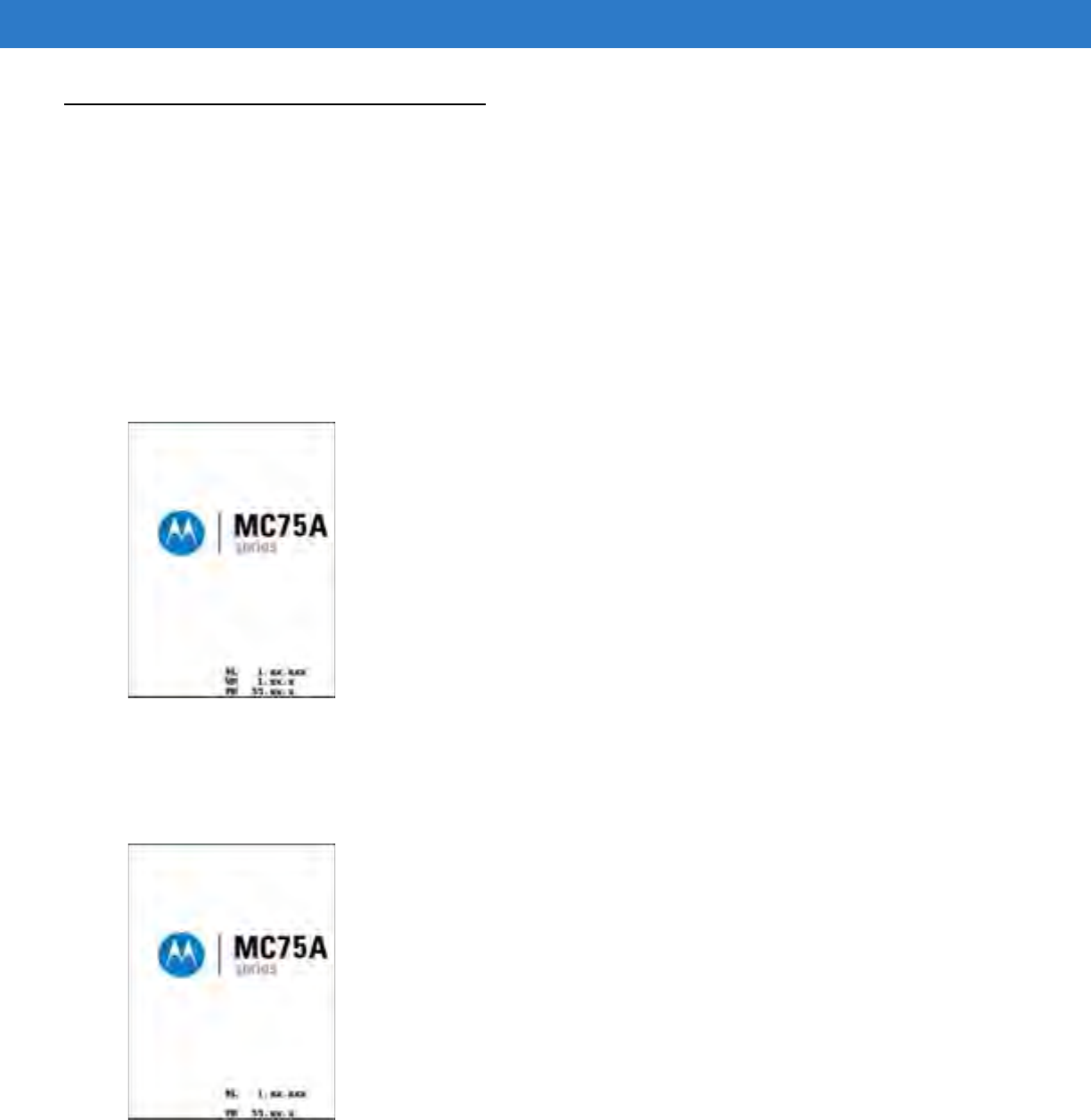
Using the MC75A 2 - 17
Resetting the MC75A
There are two reset functions, warm boot and cold boot. A warm boot restarts the MC75A by closing all running
programs. A cold boot also restarts the MC75A, and also resets the clock. Data saved in flash memory or a
memory card is not lost.
If the MC75A is not functioning properly, perform a warm boot first. If the MC75A still does not respond, perform a
cold boot.
Performing a Warm Boot
Hold down the Power button for approximately five seconds. As soon as the MC75A starts to boot release the
Power button.
Figure 2-16
Warm Boot Splash Screen
Performing a Cold Boot
To perform a cold boot simultaneously press the Power button and the 1 and 9 keys.
Figure 2-17
Cold Boot Splash Screen
DRAFT
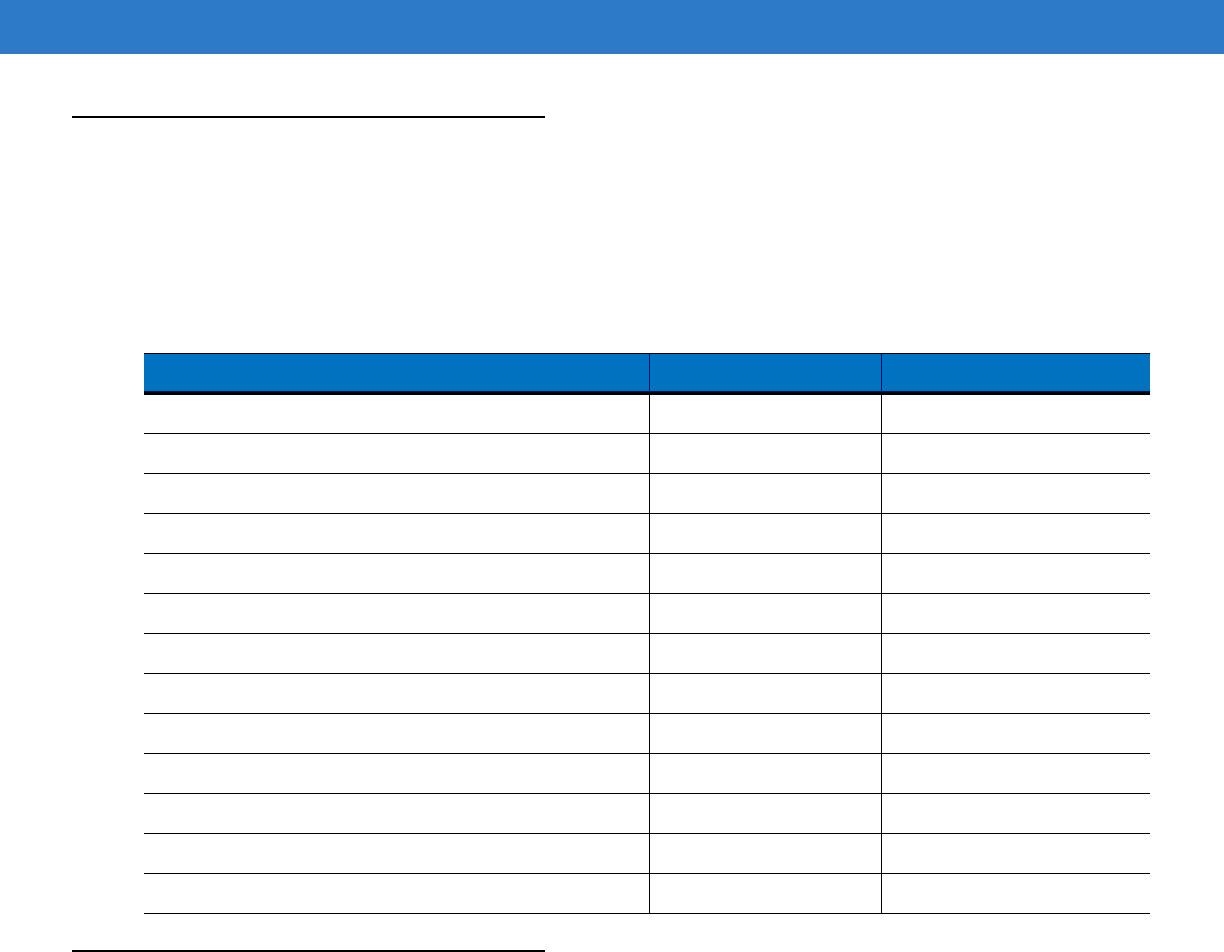
2 - 18 MC75A Enterprise Digital Assistant User Guide
Waking the MC75A
The wake-up conditions define what actions wake up the mobile computer after it has gone into suspend mode.
The mobile computer can go into suspend mode by either pressing the Power button or automatically by Control
Panel time-out settings. These settings are configurable and the factory default settings are shown in are subject to
change/update.
Locking the MC75A
Use the Device Lock feature to prevent use of the device. Note that when locked, the MC75A does not respond to
screen or keypad input.
To lock the MC75A, tap Start > Lock. The Lock screen appears.
To unlock the MC75A, side the Lock button to the left or right.
Table 2-6
Wake-up Default Settings
Condition for Wake-up Power Button Automatic Time-out
AC power is applied. No Yes
Mobile computer is inserted into a cradle. No Yes
Mobile computer is removed from a cradle. No Yes
Mobile computer is connected to a USB device. No Yes
Mobile computer is disconnected from a USB device. No Yes
A key is pressed. No Yes
The scan triggered is pressed. No Yes
The screen is touched. No No
Audio Jack No No
Audio Btn No No
Bluetooth communication Yes Yes
Incoming phone call Yes Yes
On motion No Yes
DRAFT
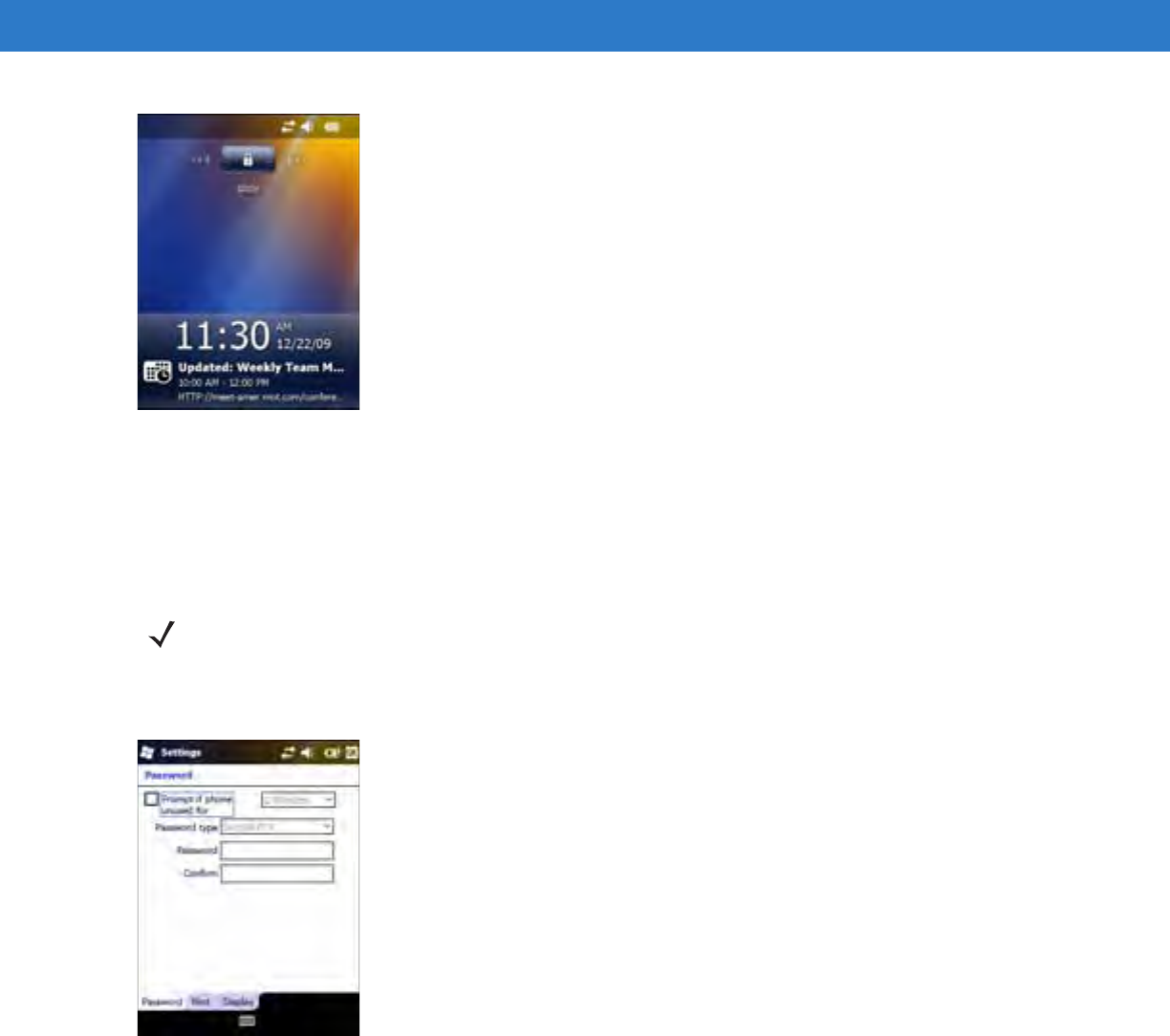
Using the MC75A 2 - 19
Figure 2-18
Unlock Device Window
If the MC75A was locked with a password, a prompt appears for the password.
Password Locking
Use the Password window to set a password to disable unauthorized access to the MC75A.
1. Tap Start > Settings > Lock icon > Password tab.
Figure 2-19
Password Window - Password Tab
2. Select Prompt if device unused for check box to enable password protection.
3. From the drop-down list, select a time value for the protection to take affect after non-use.
4. From the Password type: drop-down list, select either Simple PIN or Strong alphanumeric.
5. For a simple password, enter a four-digit password in the Password field.
For a stronger password:
a. Enter a seven character password in the Password: field. A strong password must contain at least seven
characters and contain at least three of the following: uppercase and lowercase letters, numerals, and
punctuation.
NOTE If the device is configured to connect to a network, use a strong (difficult to figure out) password
to help protect network security. Password cracking tools continue to improve and the
computers used to crack passwords are more powerful than ever.
DRAFT
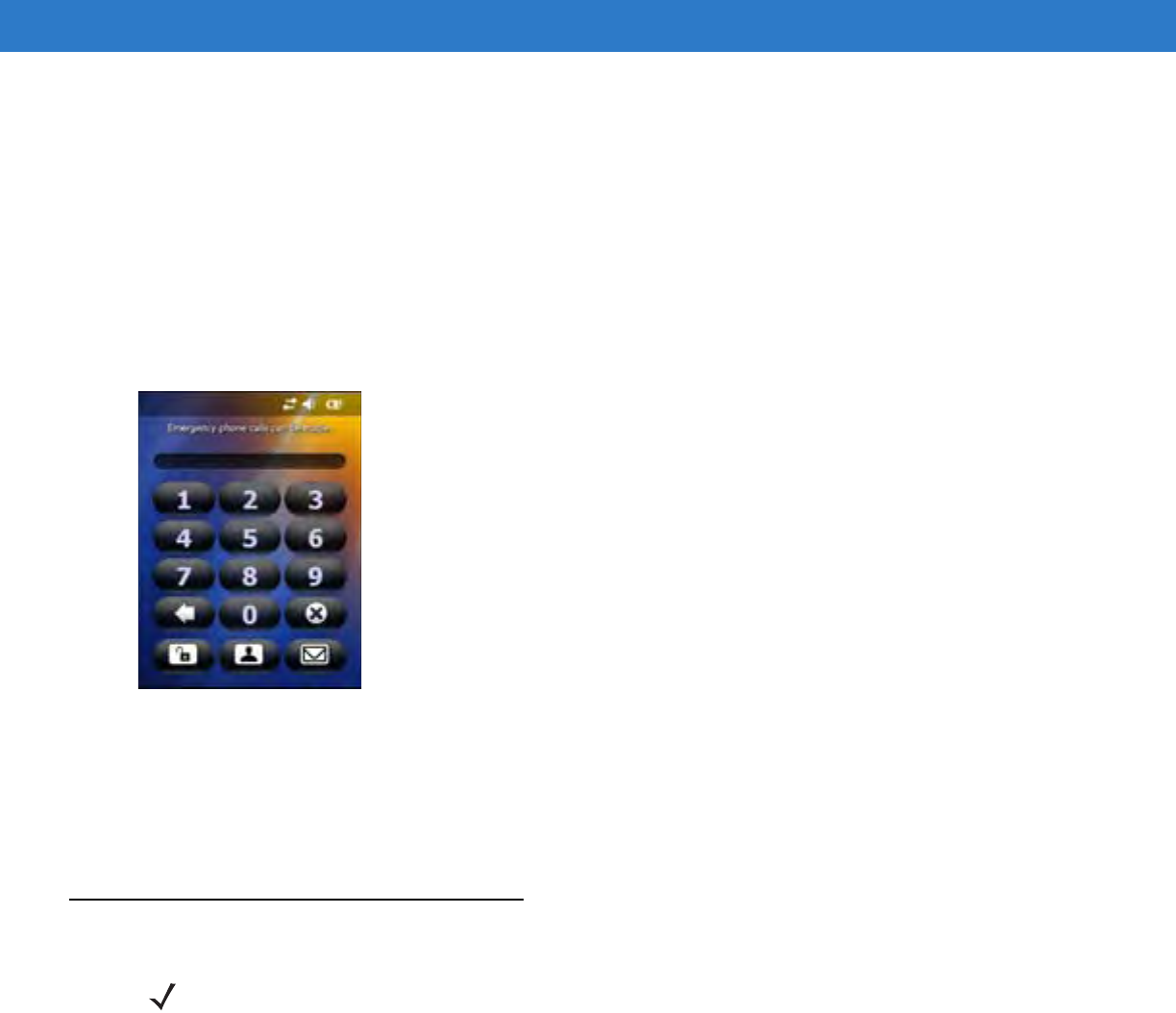
2 - 20 MC75A Enterprise Digital Assistant User Guide
b. Re-enter the password in the Confirm: field.
6. Tap OK.
7. To set a hint to remember the password, tap the Hint tab.
8. In the text box, enter a hint for a password reminder.
9. Tap OK.
When the MC75A is not used for a period of time and the user tries to access the device, the Password window
appears. This also appears when the MC75A is connected to a host computer with either a cradle or
communication cable.
Figure 2-20
Enter Password Windows
Enter the password to un-lock the device.
Tap the Unlock button to unlock the device and go to the Today screen, or tap the Contact button to unlock the
device and go to the Contacts window or tap the Email button to unlock the device and go to the Messaging
window.
Function Buttons
The MC75A’s buttons perform certain functions.
NOTE You can make emergency calls even when the MC75A is locked. See for more information.
DRAFT
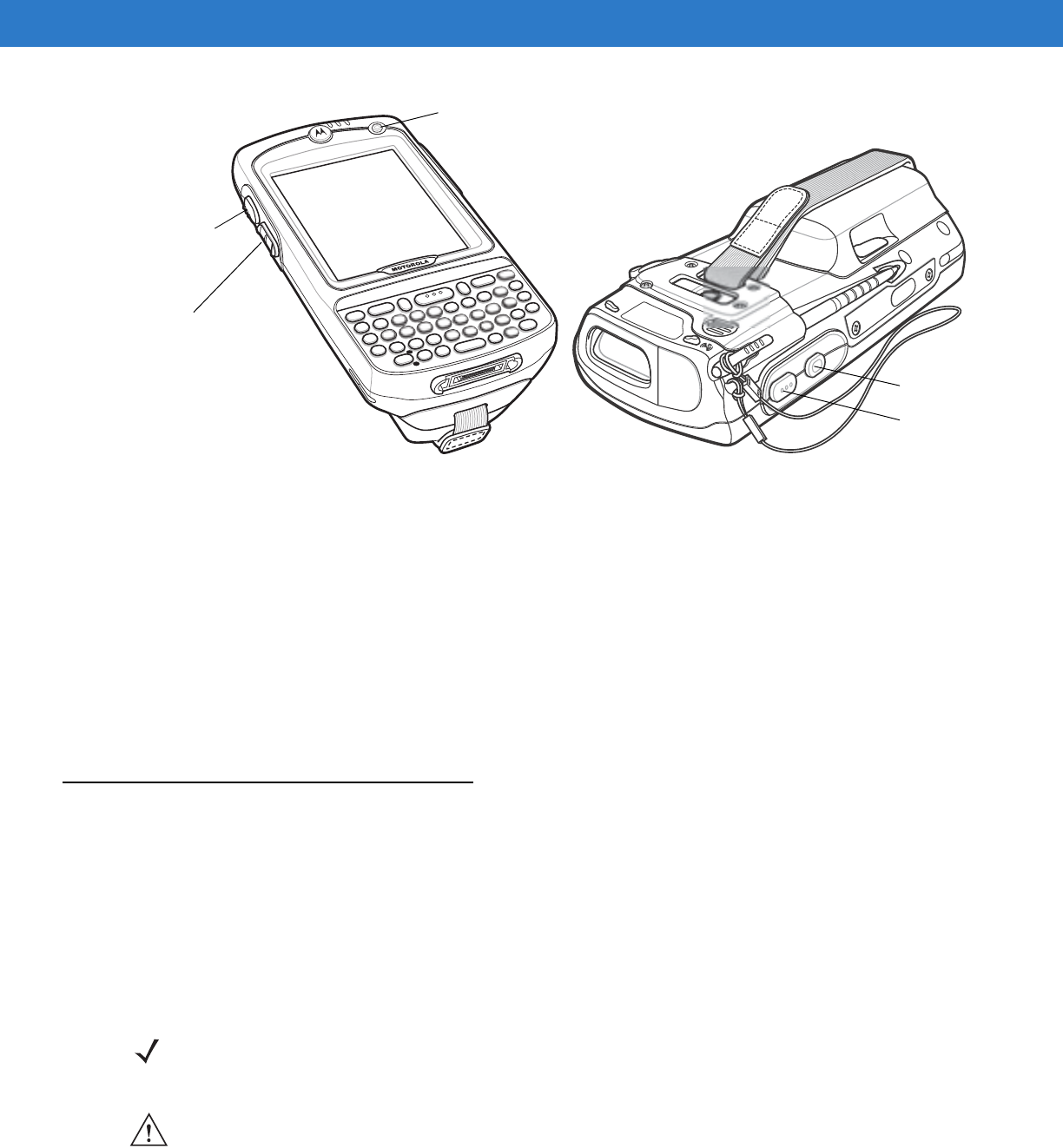
Using the MC75A 2 - 21
Figure 2-21
Function Buttons
•
Power: Press the red Power button to turn the MC75A screen on and off. The MC75A is in suspend mode
when the screen is off. For more information, see Powering On the MC75A on page 1-7. Also use the Power
button to reset the MC75A by performing a warm or cold boot. See Resetting the MC75A on page 2-17.
•
Scan/Action: Press to scan bar codes or capture images. See Chapter 3, Data Capture.
Or, press to open an application or perform a function. See the Microsoft® Applications for Mobile 6 User
Guide to set an application to open.
•
Up/Down: Press to increase or decrease the MC75A’s volume.
•
Action: Press to open an application or perform a function. See the Microsoft® Applications for Mobile 6
User Guide to set an application to open.
Stylus
Use the MC75A stylus to select items and enter information. The stylus functions as a mouse.
•
Tap: Touch the screen once with the stylus to press option buttons and open menu items.
•
Tap and Hold: Tap and hold the stylus on an item to see a list of actions available for that item. On the pop-up
menu that appears, tap the action to perform.
•
Drag: Hold the stylus on the screen and drag across the screen to select text and images. Drag in a list to
select multiple items.
Scan/Action
Button
Power Button
Up/Down Button
Action Button
Scan/Action
Button
NOTE Motorola recommends using the spring-loaded tip of the stylus to write on the screen, and the back end of the
stylus to tap the screen. Use your finger to press the Power button and keypad buttons.
CAUTION To prevent damage to the screen, do not use any device other than the Motorola-provided stylus.
DRAFT
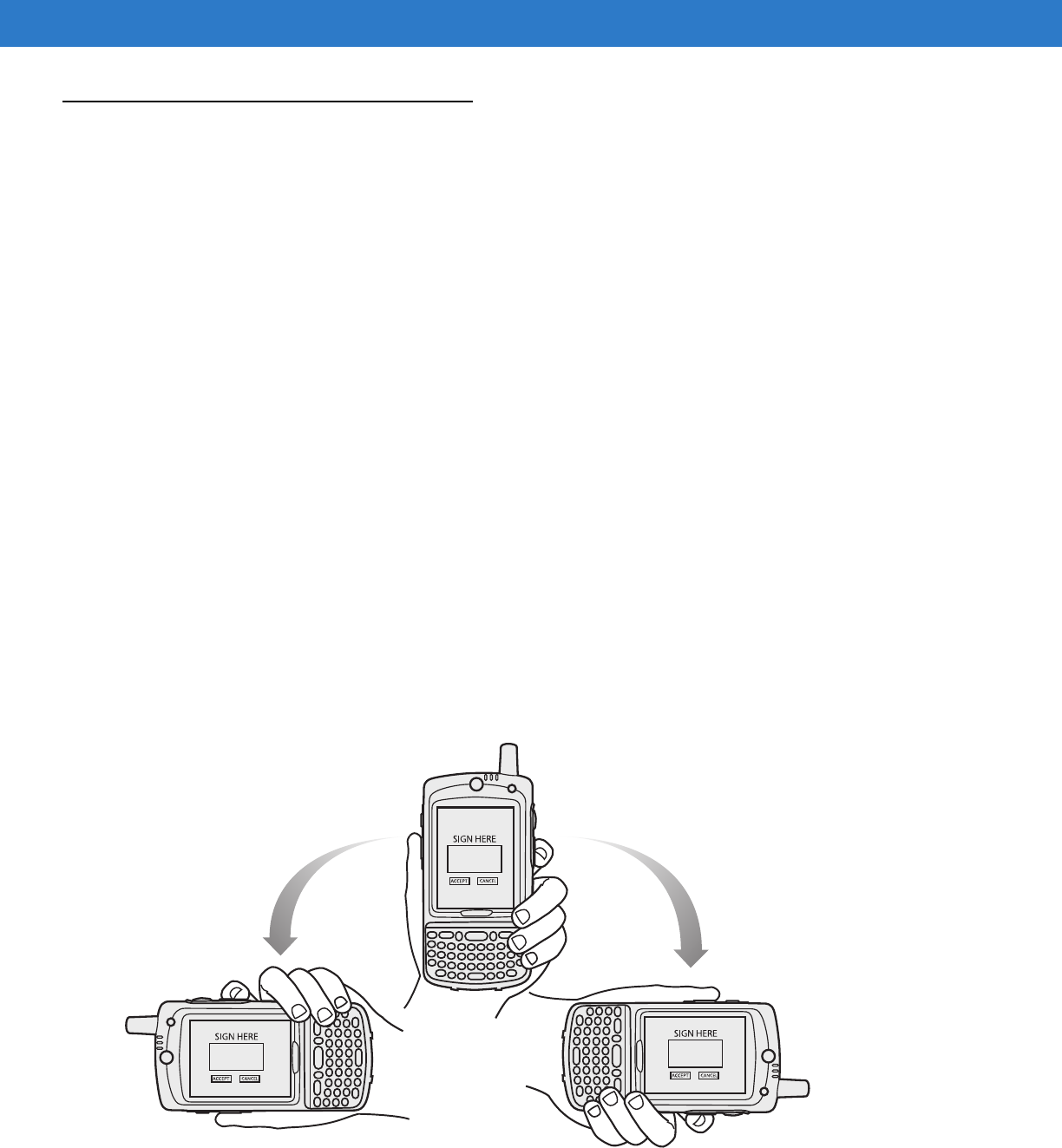
Using the MC75A 2 - 23
Interactive Sensor Technology
This section describes the functionality of the Interactive Sensor Technology (IST) feature on the MC75A.
The IST supports the following features.
•
Power Management – manage power by configuring IST to control switching on/off the backlight, control
suspend mode of the MC75A by monitoring motion and orientation.
•
Display Orientation – switch the screen orientation to either landscape or portrait depending on the MC75A
orientation.
•
Free Fall Detection – monitors free fall duration and records the time and type of the drop event.
Power Management
The MC75A orientation and motion sensitive data can be used as an indicator of MC75A usage and can be used to
manage the battery power of the mobile computer. For example, IST can be configured to control the backlight on
and off functionality or go into suspend according to a user gesture by placing screen facing down. It can also be
used to keep the MC75A active while it is in movement to prevent it from quickly going into suspend mode while in
use.
Display Orientation
The screen can be rotated between portrait and landscape modes automatically, depending on the physical
orientation of the MC75A. For example, if the MC75A is rotated 90° counterclockwise, IST rotates the display
counterclockwise 90° so that the screen display appears correct.
This functionality is achieved by monitoring screen angle and rotating the display to counter any changes. IST only
rotates the screen in multiples of 90°.
Figure 2-23
Display Orientation
DRAFT
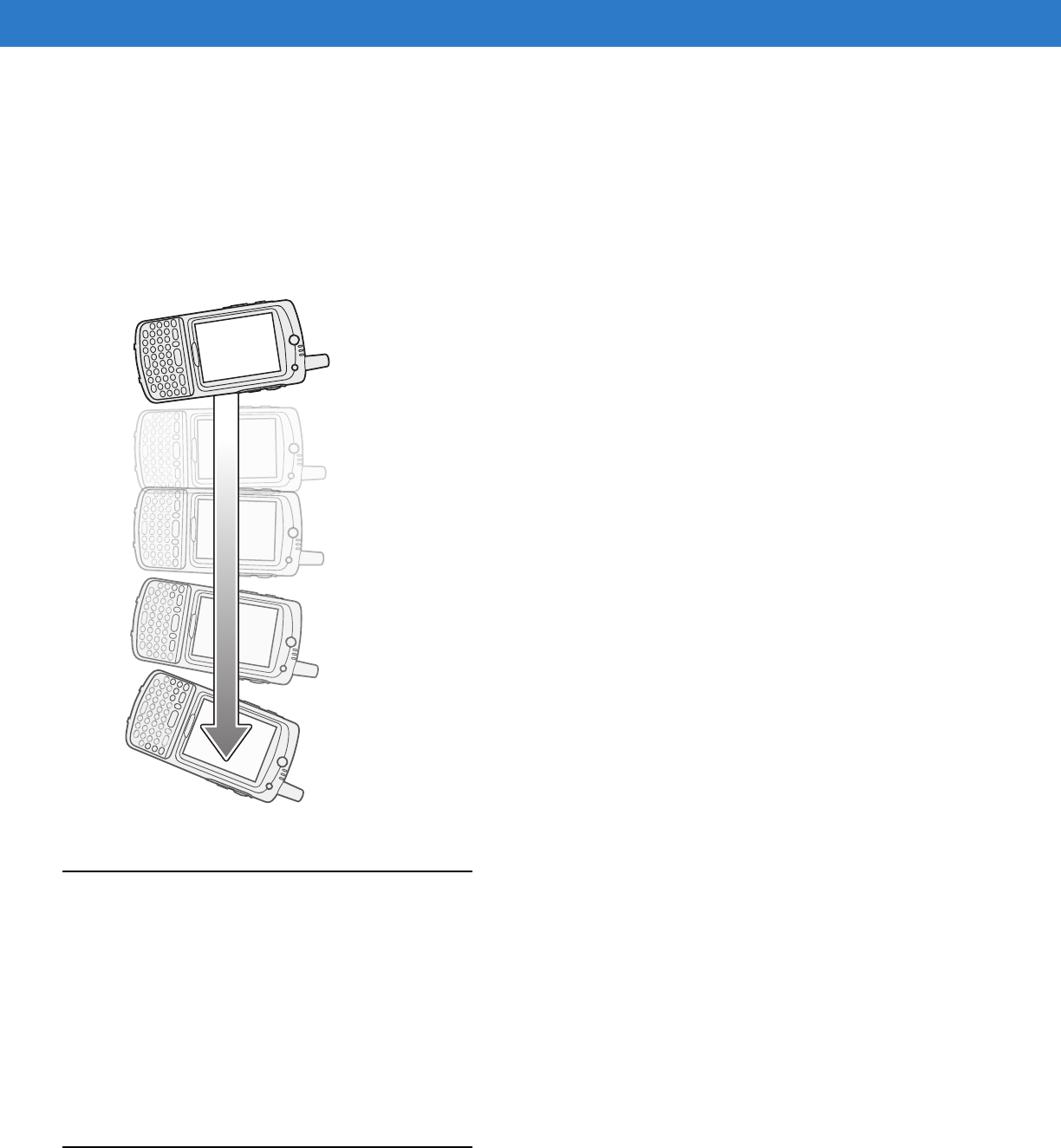
2 - 24 MC75A Enterprise Digital Assistant User Guide
Free Fall Detection
IST continuously monitors gravitational force on the MC75A according to its current position. When the MC75A
free falls, IST detects the absence of gravitational force and records the event data if it detects a free fall more than
450 ms, which may indicates nearly a one meter drop. This data can be used as an indicator of potential abuse or
misuse.
IST features a log for recording the free fall events. This log records the date, time and the time period of the free
fall.
Figure 2-24
Free Fall Detection
Taking Photos
To take a photo:
1. Tap Start > Pictures & Videos icon.
2. Tap Camera on the command bar.
3. Check the image on the view finder, adjust if necessary.
4. Press the Enter key to take the picture. Hold the MC75A still until the camera flash occurs or the shutter sound
is heard.
Recording Video
To record a video clip:
DRAFT
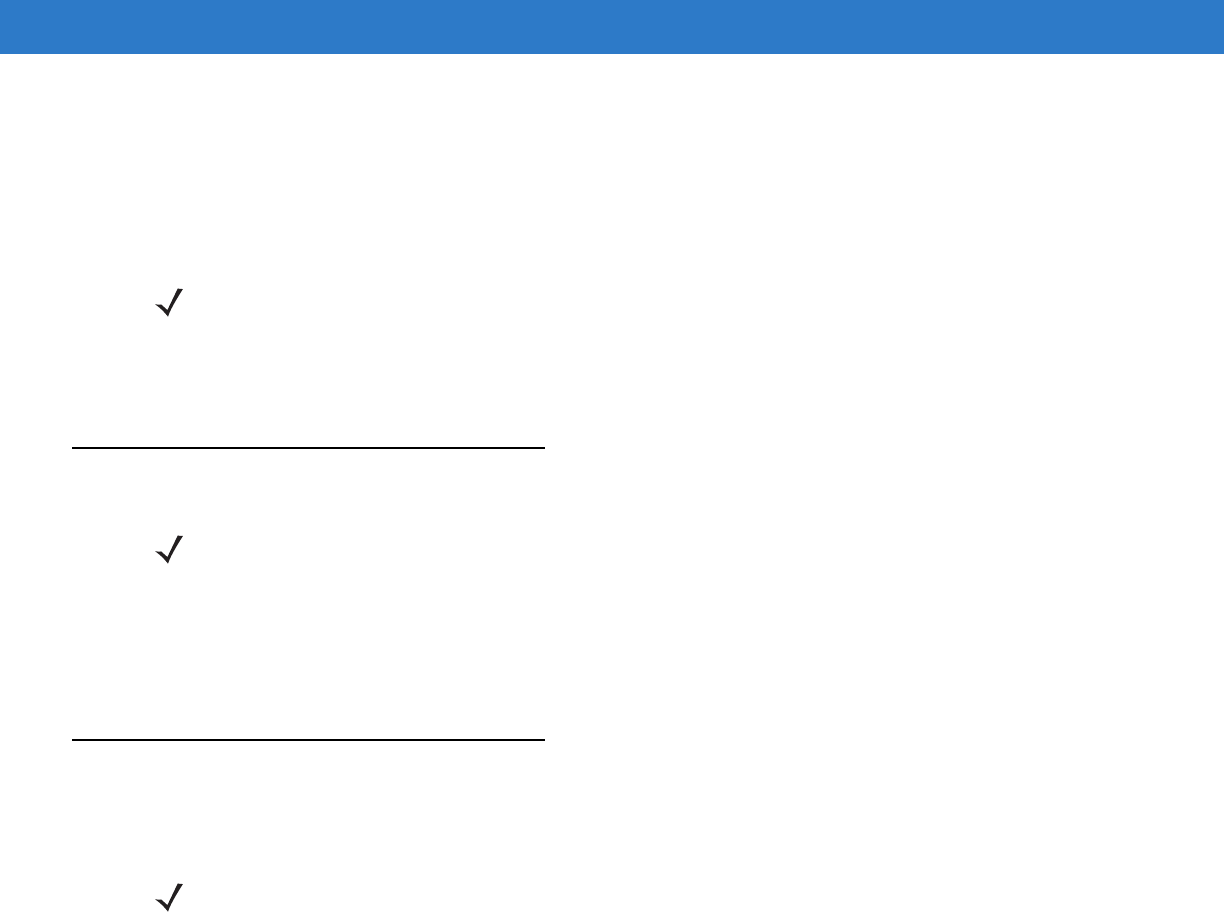
Using the MC75A 2 - 25
1. Tap Start > Pictures & Videos icon.
2. Tap Camera on the command bar.
3. Tap Menu > Video to set shooting mode to video.
The available recording time displays on the screen.
4. Press the Enter key to begin recording.
Recording stops when you press the Enter button again.
Viewing Photos and Videos
To view photos and video clips:
1. Tap Start > Pictures & Videos icon.
2. Tap the picture or video clip to view.
Using IrDA
In a Microsoft Windows Mobile program (except Messaging), and Picture & Videos, you can exchange files using
either infrared or Bluetooth.
First activate the beam function before exchanging files with another IrDA device.
To activate the Beam function:
1. Tap Start > Settings > Connections folder > Beam icon.
2. Tap Receive all incoming beams check box.
NOTE By default, the time limit for recording videos is set to 30 seconds.
NOTE For detailed information on the Photos and Videos, refer to the Microsoft Applications User Guide for
Mobile 6, p/n 72E-108299-xx.
NOTE You can also beam files (not folders) from the File Explorer window. Tap and hold the item you want to
send, then tap Beam File from the pop-up menu.
DRAFT
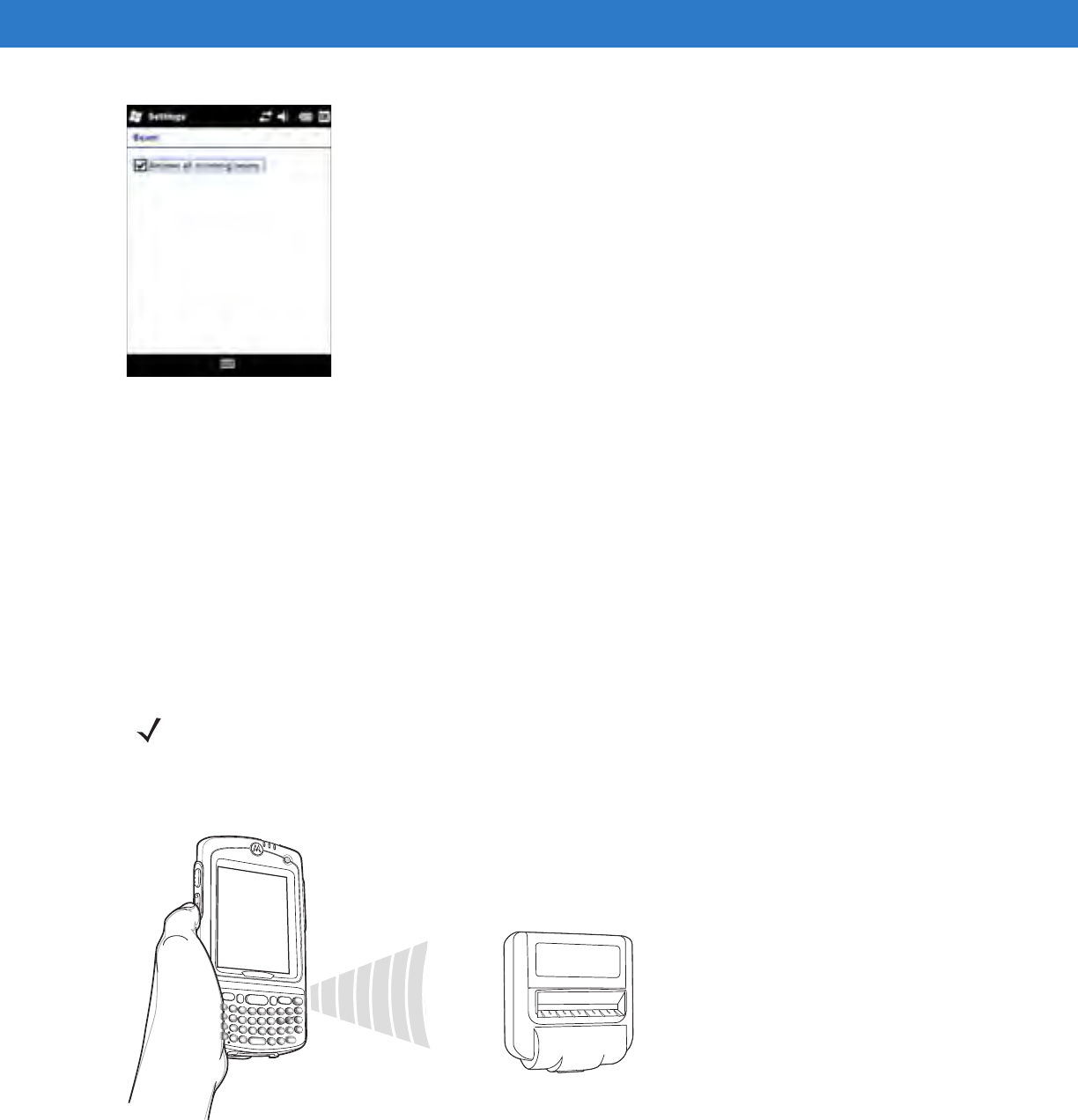
2 - 26 MC75A Enterprise Digital Assistant User Guide
Figure 2-25
Beam Window
3. Tap OK.
Infrared Connection
Using infrared, you can enable short-range file exchange between your MC75A and another IrDA device.
Exchanging Files using IR Connection
Ensure that the IrDA function on both the MC75A and the other device are enabled.
To send files via IrDA connection:
1. Switch to the program where you created the item you want to send and locate the item in the list.
2. Align the IrDA port of the MC75A with that of the IrDA device so that they are unobstructed and within a close
range.
Figure 2-26
Align MC75A with IrDA Device
3. Tap and hold the item, then tap Beam [type of item] on the pop-up menu.
4. Tap the device that you want to send the file to.
NOTE Do not cover or block the IrDA window.
DRAFT
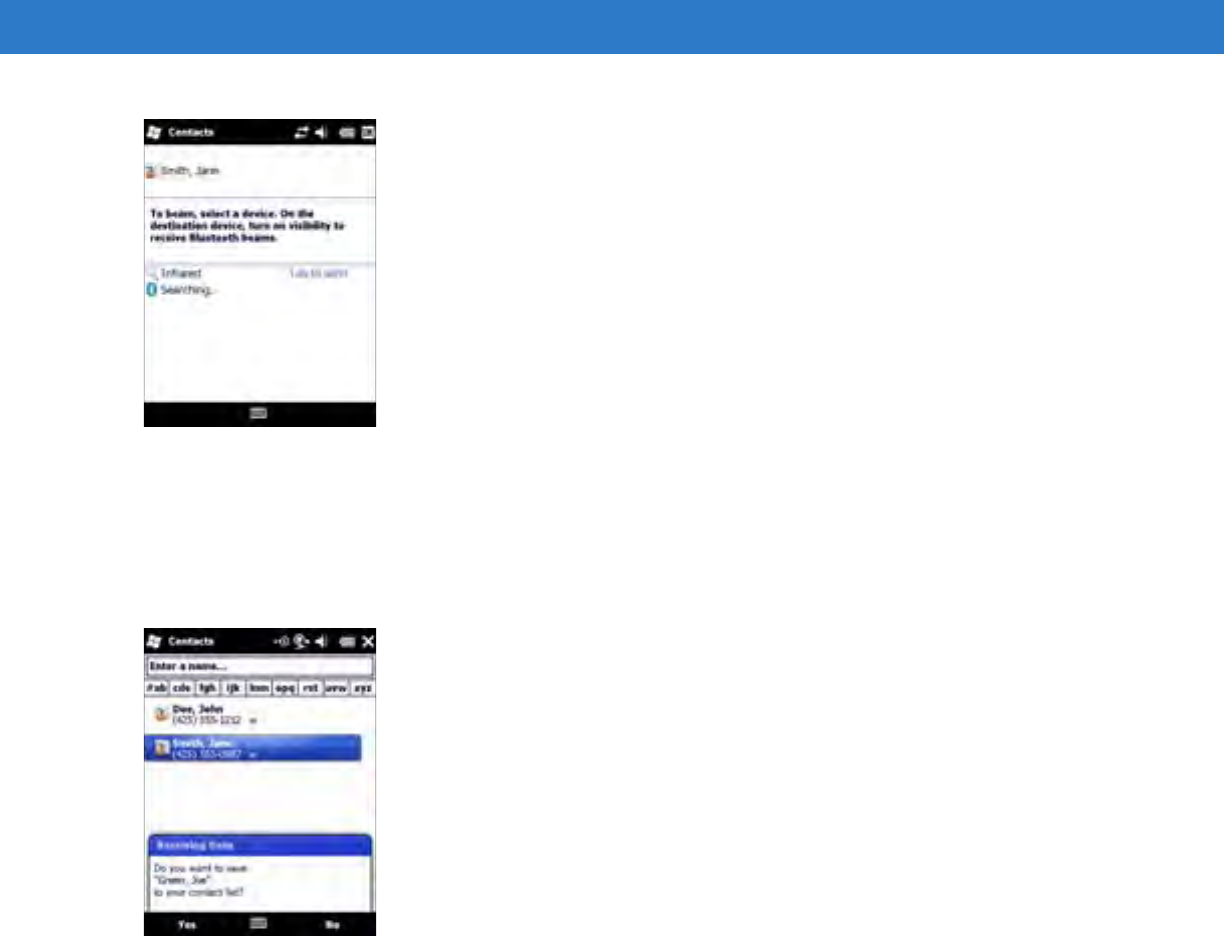
Using the MC75A 2 - 27
Figure 2-27
Beam Contact
To receive files via IrDA connection:
1. Align the IrDA port of the MC75A with that of the other IrDA device so that they are unobstructed and within a
close range.
2. On the other device, send the file to the MC75A.
Figure 2-28
Receive File
3. When the Receiving Data dialog displays, tap Yes.
DRAFT

2 - 28 MC75A Enterprise Digital Assistant User Guide
DRAFT

Chapter 3 Data Capture
Introduction
The MC75A offers three types of data capture options:
•
Laser scanning
•
Imaging
•
Color digital camera.
Laser Scanning
An MC75A with an integrated laser scanner has the following features:
•
Reading of a variety of bar code symbologies, including the most popular 1-D code types.
•
Intuitive aiming for easy point-and-shoot operation.
Scanning Considerations
Typically, scanning is a simple matter of aim, scan, and decode and a few quick trial efforts master it. However,
consider the following to optimize scanning performance:
•
Range
Any scanning device decodes well over a particular working range — minimum and maximum distances from
the bar code. This range varies according to bar code density and scanning device optics.
Scanning within range brings quick and dependable decodes; scanning too close or too far away prevents
decodes. Move the scanner closer or further away to find the right working range for the bar codes being
scanned.
•
Angle
Scanning angle is important for promoting quick decodes.
NOTE To perform data capture a scanning enabled application must be installed on the MC75A. A sample scanning
application can be downloaded from the Motorola Support site at http://support.symbol.com.
DRAFT
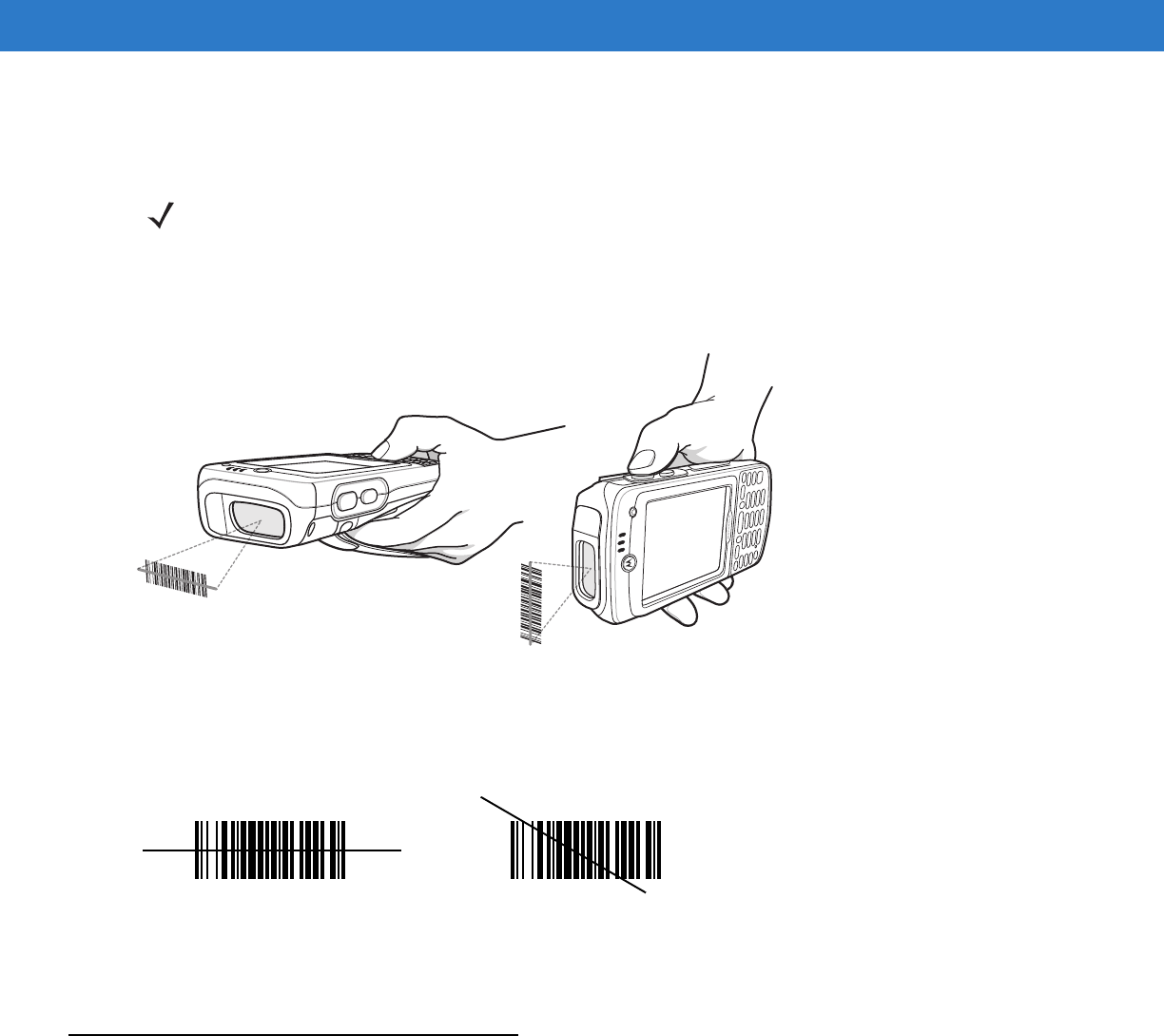
3 - 2 MC75A Enterprise Digital Assistant User Guide
•
Hold the MC75A farther away for larger symbols.
•
Move the MC75A closer for symbols with bars that are close together.
Bar Code Scanning
1. Ensure that a scan enabled application is loaded on the MC75A.
Figure 3-1
Linear Scanning
2. Press and hold the scan button. The laser beam exits from the end of the MC75A. Ensure the red scan beam
covers the entire bar code. The Scan/Decode LED lights red to indicate that scanning is in process, then lights
green and a beep sounds, by default, to indicate the bar code was decoded successfully.
Figure 3-2
Linear Scanner Aiming Pattern
3. Release the scan button.
Imaging
An MC75A with an integrated imager has the following features:
•
Omnidirectional reading of a variety of bar code symbologies, including the most popular linear, postal,
PDF417, and 2D matrix code types.
•
The ability to capture and download images to a host for a variety of imaging applications.
•
Advanced intuitive laser aiming for easy point-and-shoot operation.
The imager uses digital camera technology to take a digital picture of a bar code, stores the resulting image in its
memory, and executes state-of-the-art software decoding algorithms to extract the data from the image.
NOTE Scanning procedures depend on the application and MC75A configuration. An application may use different
scanning procedures from the one listed above.
Incorrect
Correct
DRAFT
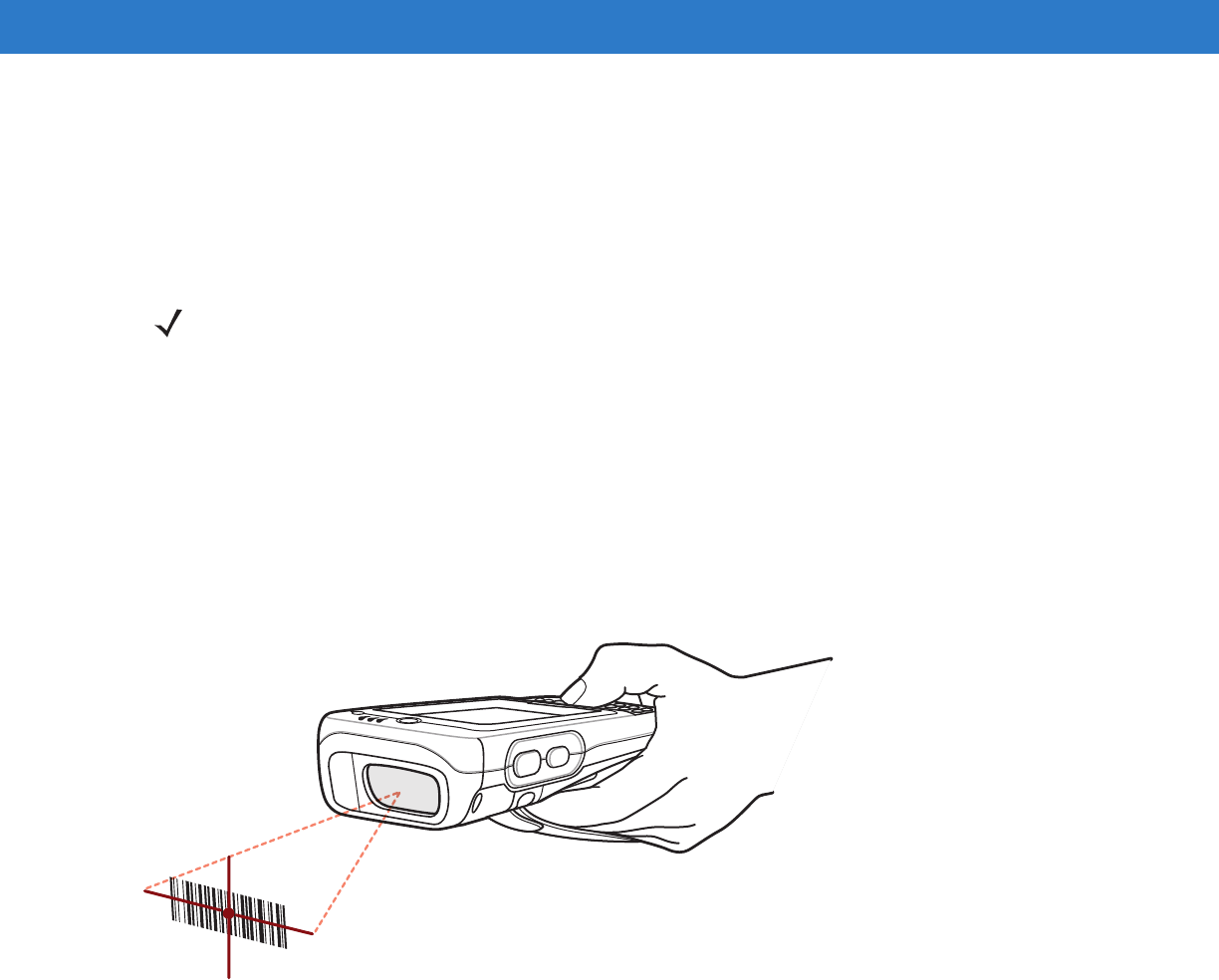
Data Capture 3 - 3
Operational Modes
MC75A with an integrated imager support three modes of operation, listed below. Activate each mode by pulling
the trigger or pressing the Scan button.
•
Decode Mode: In this mode, the MC75A attempts to locate and decode enabled bar codes within its field of
view. The imager remains in this mode as long as you hold the trigger, or until it decodes a bar code.
•
Pick List Mode: This mode allows you to selectively decode a bar code when more than one bar code is in
the MC75A’s field of view. To accomplish this, move the aiming crosshair over the required bar code to
decode only this bar code. This feature is ideal for pick lists containing multiple bar codes and manufacturing
or transport labels containing more than one bar code type (either 1D or 2D).
•
Image Capture Mode: Use this mode to capture an image within the MC75A’s field of view. This is useful for
capturing signatures or images of items like damaged boxes.
Imager Scanning
1. Ensure that a scan-enabled application is loaded on the MC75A.
Figure 3-3
Imager Scanning
2. Press and hold the scan button. The red laser aiming pattern turns on to assist in aiming. Ensure the bar code
is within the area formed by the brackets in the aiming pattern. The Scan/Decode LED lights red to indicate that
scanning is in process, then lights green and a beep sounds, by default, to indicate the bar code was decoded
successfully. Note that when the MC75A is in Pick List Mode, the imager does not decode the bar code until
the crosshair touches the bar code.
NOTE To enable Pick List Mode, download the Control Panel applet from the web site at http://support.symbol.com.
Pick List can also be set in an application using a API command.
DRAFT
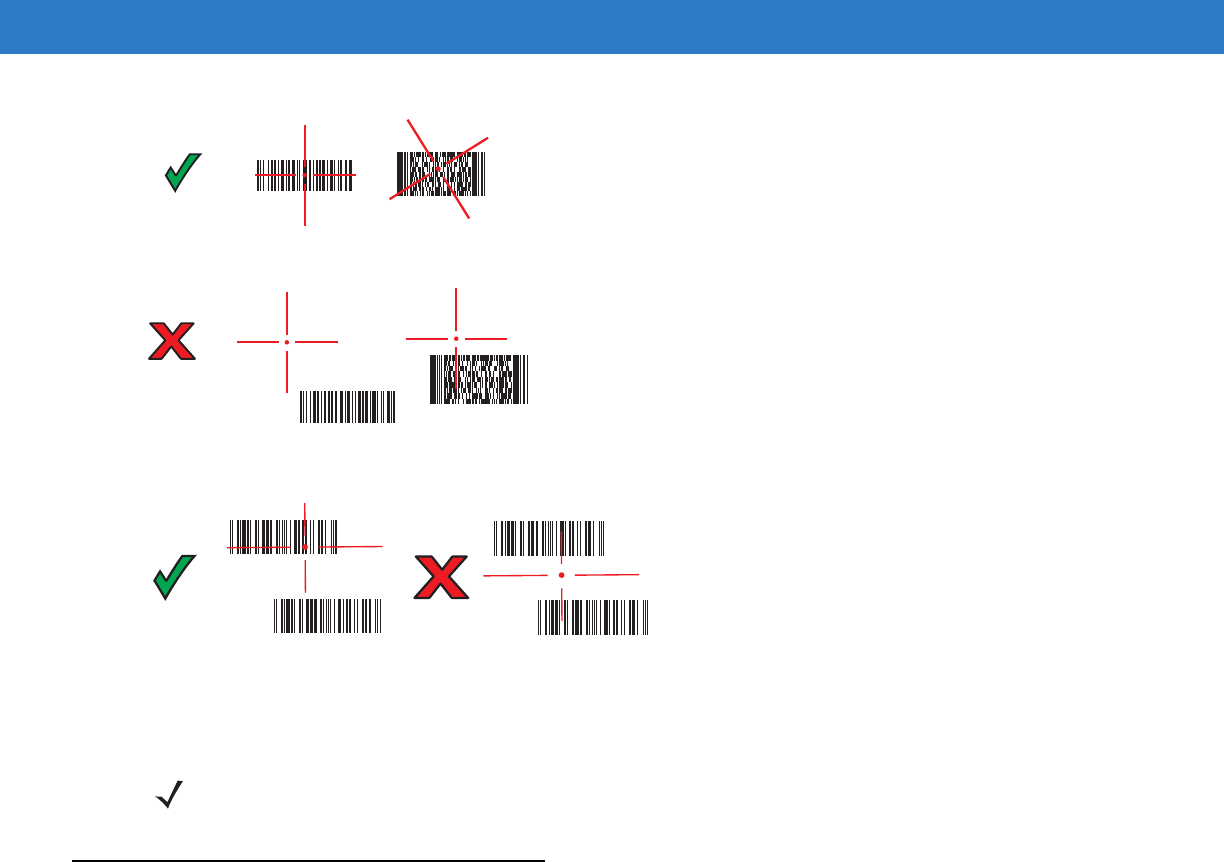
3 - 4 MC75A Enterprise Digital Assistant User Guide
Figure 3-4
Imager Aiming Pattern
Figure 3-5
Pick List Mode with Multiple Bar Codes
3. Release the scan button.
Color Digital Camera
MC75A with an integrated color digital camera have the following features:
•
Omnidirectional reading of a variety of bar code symbologies, including the most popular linear, postal,
PDF417, and 2D matrix code types.
•
Advanced intuitive aiming for easy point-and-shoot operation.
Digital Camera Scanning
1. Ensure that a scan-enabled application is loaded on the MC75A.
2. Aim the camera lens on the back of the MC75A at a bar code.
3. Press and hold the scan button. A preview window appears on the display window with a red aiming reticle in
the center. The Scan/Decode LED lights red to indicate that scanning is in process.
NOTE Imager decoding usually occurs instantaneously. The MC75A repeats the steps required to take a digital
picture (image) of a poor or difficult bar code as long as the scan button remains pressed.
DRAFT
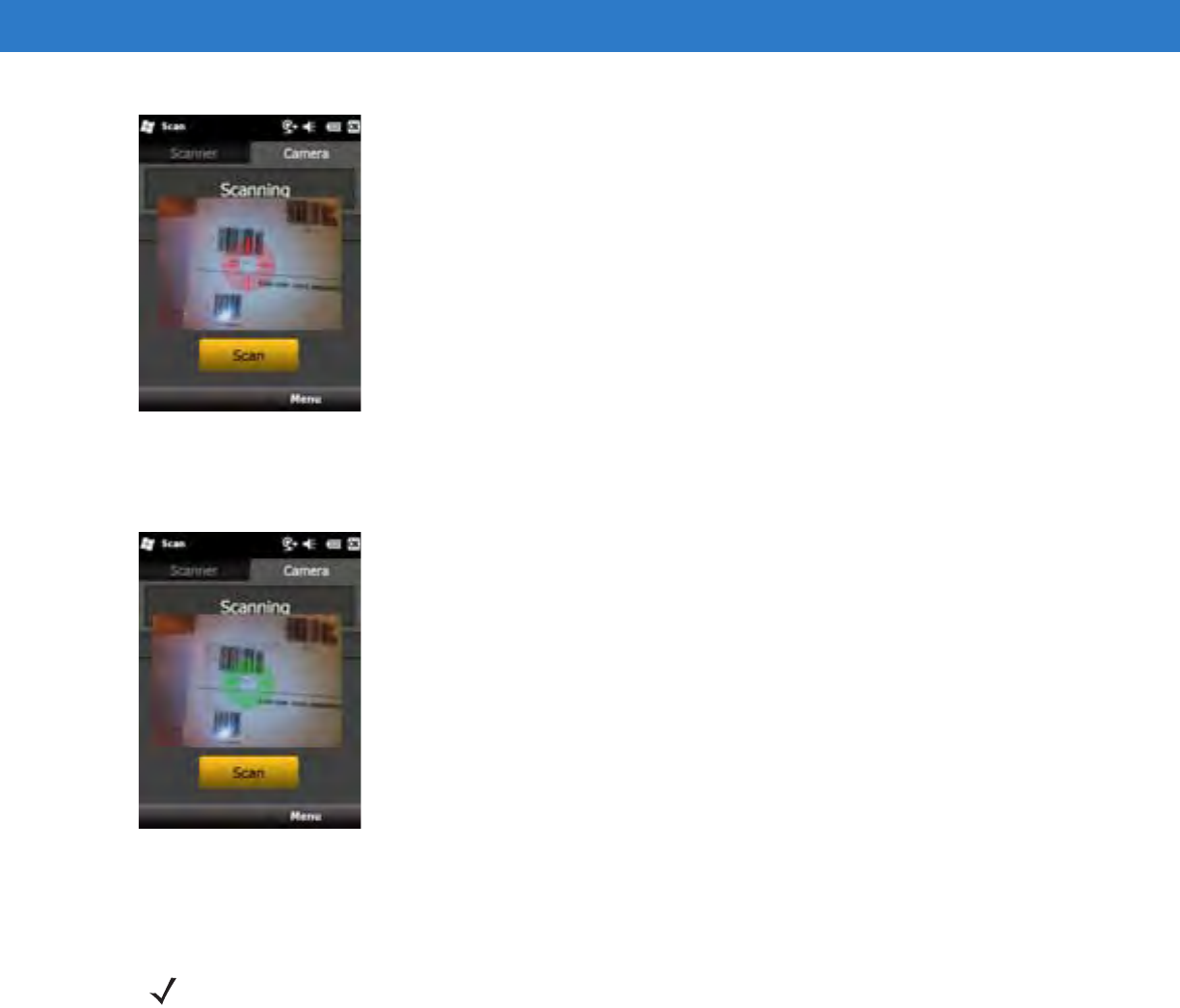
Data Capture 3 - 5
Figure 3-6
Sample Scan Application with Preview Window
4. Move the MC75A until the red aiming reticle is on the bar code to scan. The aiming reticle turns green when
the MC75A is able to decode the bar code.
Figure 3-7
Digital Camera Scanning
5. Release the scan button. The Scan/Decode LED lights green and a beep sounds, by default, to indicate the
bar code was decoded successfully.
NOTE The camera decode feature is set by default to automatically decode the bar code when read. This feature
can be programmed to display a green aiming reticle upon good decode indicating that the bar code has
been successfully decoded and to that the scan button may be released.
DRAFT

3 - 6 MC75A Enterprise Digital Assistant User Guide
DRAFT
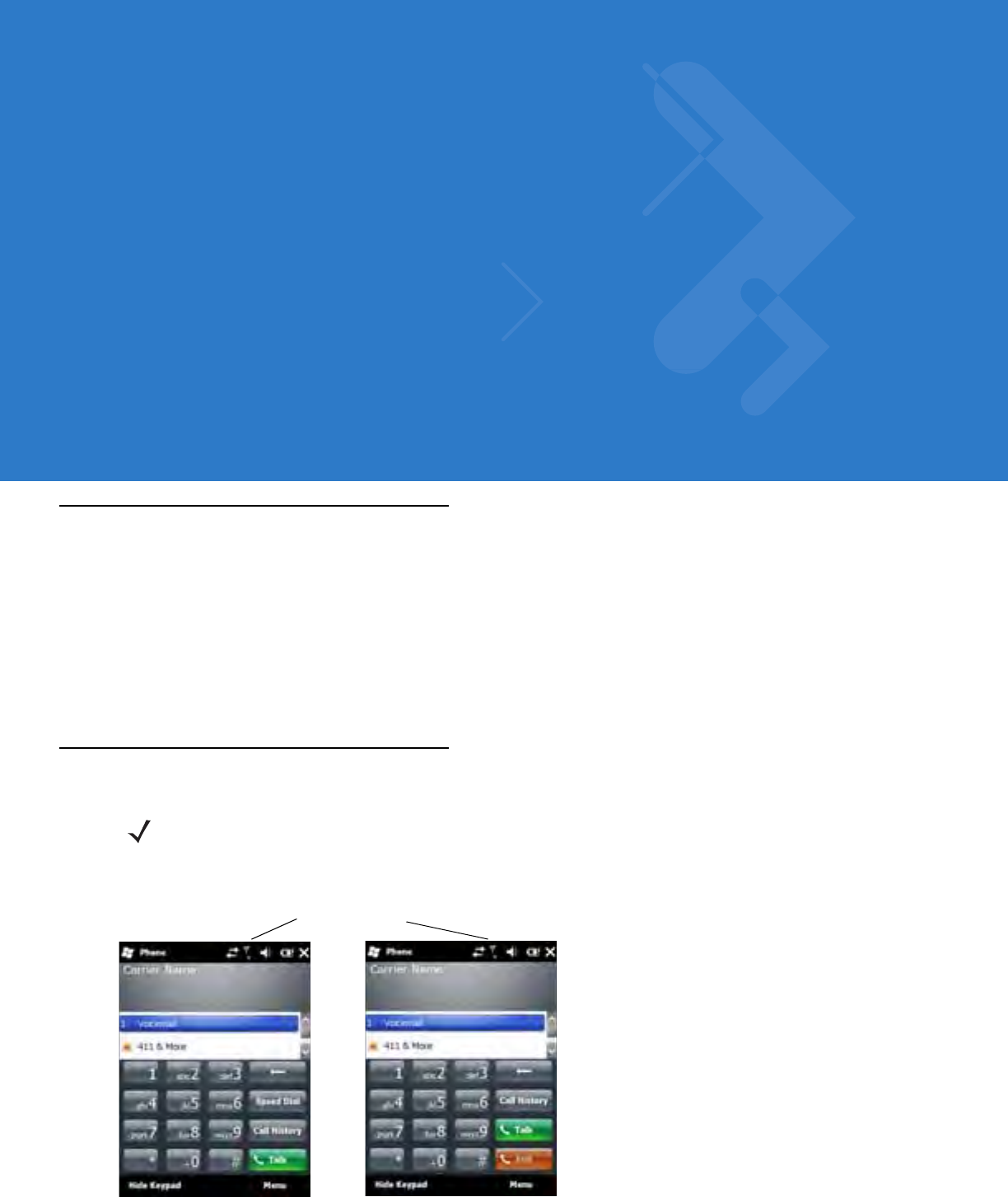
Chapter 4 Using the Phone
Introduction
Use the MC75A to make phone calls, set up speed dials, keep track of calls, and send text messages. Your
wireless service provider may also provide other services such as voice mail, call forwarding, and caller ID.
Also use the integrated phone to connect to an ISP or work network in order to browse the Web and read e-mail.
Connect to the Internet or work network over High-Speed Downlink Packet Access (HSDPA) (MC75A6) or
Evolution Data-Optimized (EvDO) (MC75A8) using Cellular Line, or using the modem specified by the mobile
operator. For more information, or to customize the MC75A phone by changing phone settings, see the MC75A
Integrator Guide.
Accessing the Phone Keypad
Access the keypad regardless of the program in use. Applications on the MC75A can be in use during a call.
Figure 4-1
Phone Keypads
NOTE Keypads vary depending on the carrier, services and the state of the phone. For example, place calls on hold
and use Swap to switch active calls on hold. (See Conference Calling on an MC75A6 on page 4-19.)
Antenna Signal
MC75A8
MC75A6
DRAFT
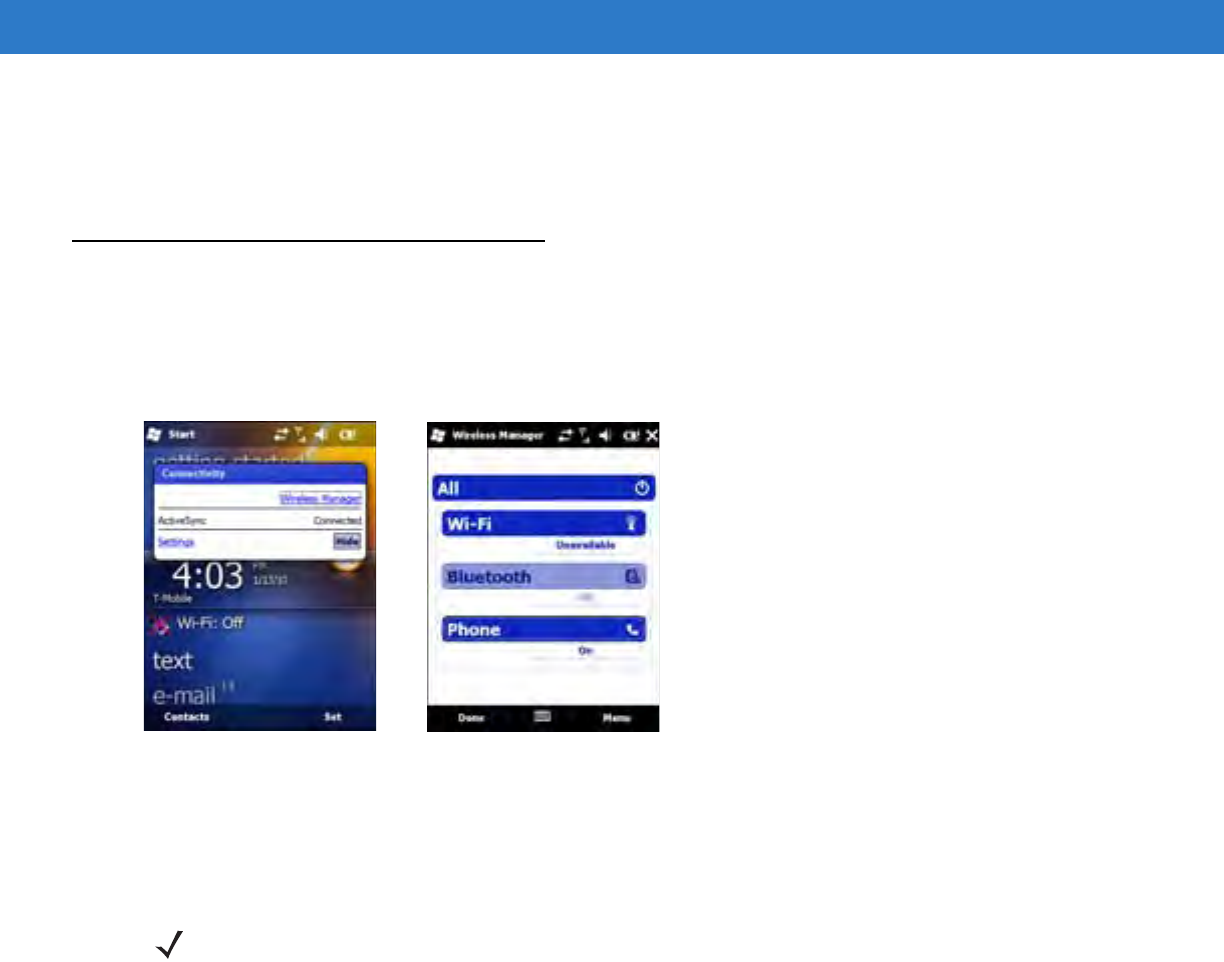
4 - 2 MC75A Enterprise Digital Assistant User Guide
To access the phone keypad tap Start > Phone or press the green phone key on the MC75A’s keypad.
To receive calls when the MC75A is suspended, leave the phone radio turned on and ensure the MC75A is set to
wake with any key.
Turning the Phone On and Off
Windows Mobile 6 devices include Wireless Manager, which provides a simple method of enabling and disabling
the phone.
To open Wireless Manager, tap the Connectivity icon.
Figure 4-2
Opening Wireless Manager
Select Wireless Manager. The Wireless Manager window appears.
To toggle on or off the phone, tap blue Phone bar.
To configure settings for a connection, tap Menu > Phone Settings.
NOTE To receive calls when your device is suspended, leave the phone turned on.
DRAFT
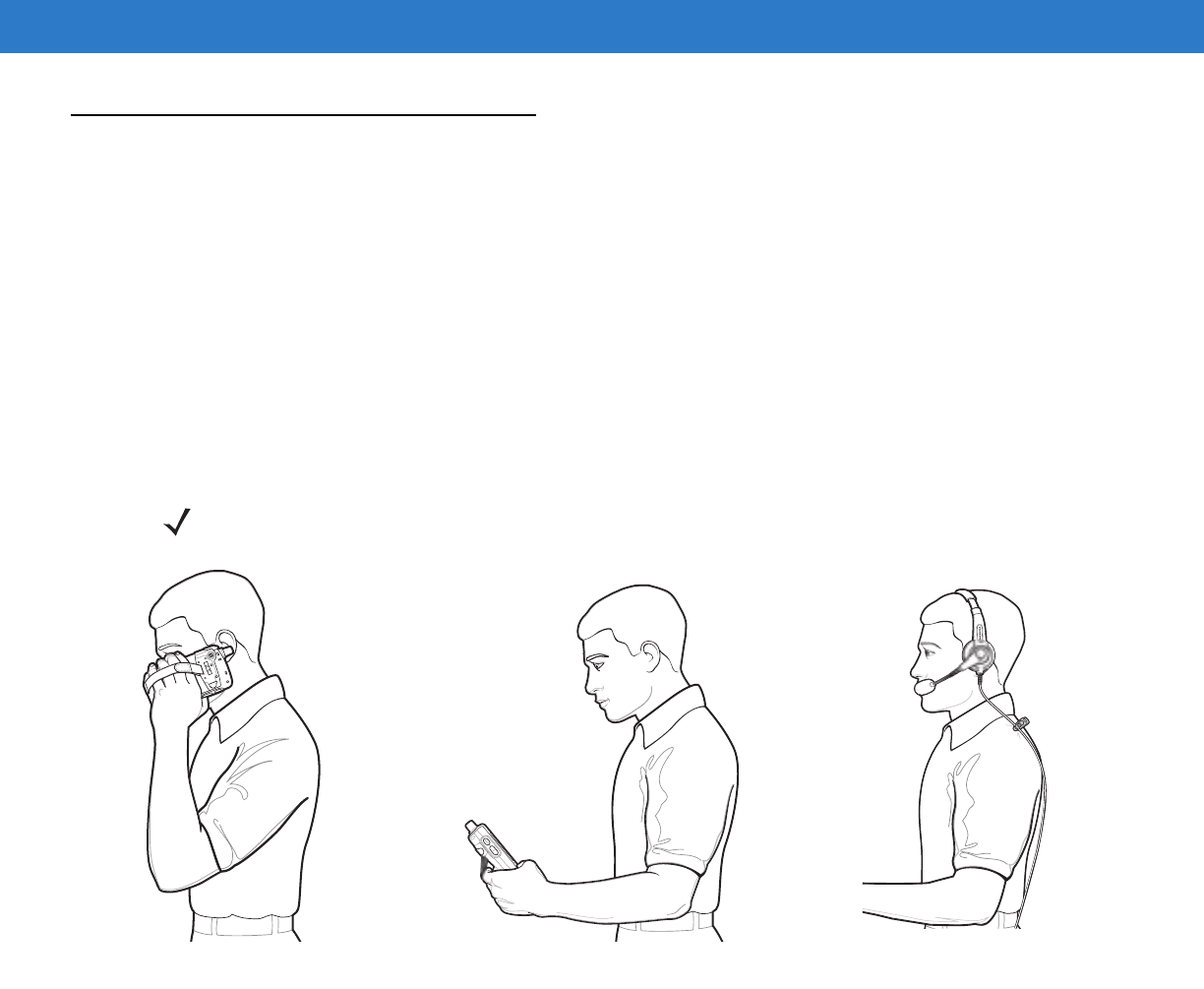
Using the Phone 4 - 3
Audio Modes
The MC75A offers three audio modes for use during phone calls:
•
Handset Mode: Switches audio to the speaker at the top front of the MC75, so you can use the MC75A as a
handset. This is the default mode.
•
Speaker Mode: Use the MC75A as if on speaker phone. Tap the Speaker On button to activate this mode.
Tap the Speaker Off button to switch back to handset mode.
•
Headset Mode: Connect a wired or Bluetooth headset to automatically switch audio to the headset.
The MC75A defaults to handset mode. When a wired headset is plugged into the MC75A audio connector or a
Bluetooth headset is configured for use with the MC75, the earpiece and speakerphone are muted and audio is
heard through the headset.
Figure 4-3
Audio Modes
Using a Wired Headset
You can use a stereo headset for audio communication when using an audio-enabled application. To use a
headset, plug the headset jack into the audio connector on the side of the MC75A. Set the MC75A’s volume
appropriately before putting the headset on. Plugging a headset into the jack mutes the speaker.
For the best audio performance, Motorola recommends a 2.5mm jack headset, see Chapter 7, Accessories.
NOTE While using a Bluetooth headset during a call, the mobile computer will not go into suspend mode.
Headset ModeHandset Mode Speaker Mode
DRAFT
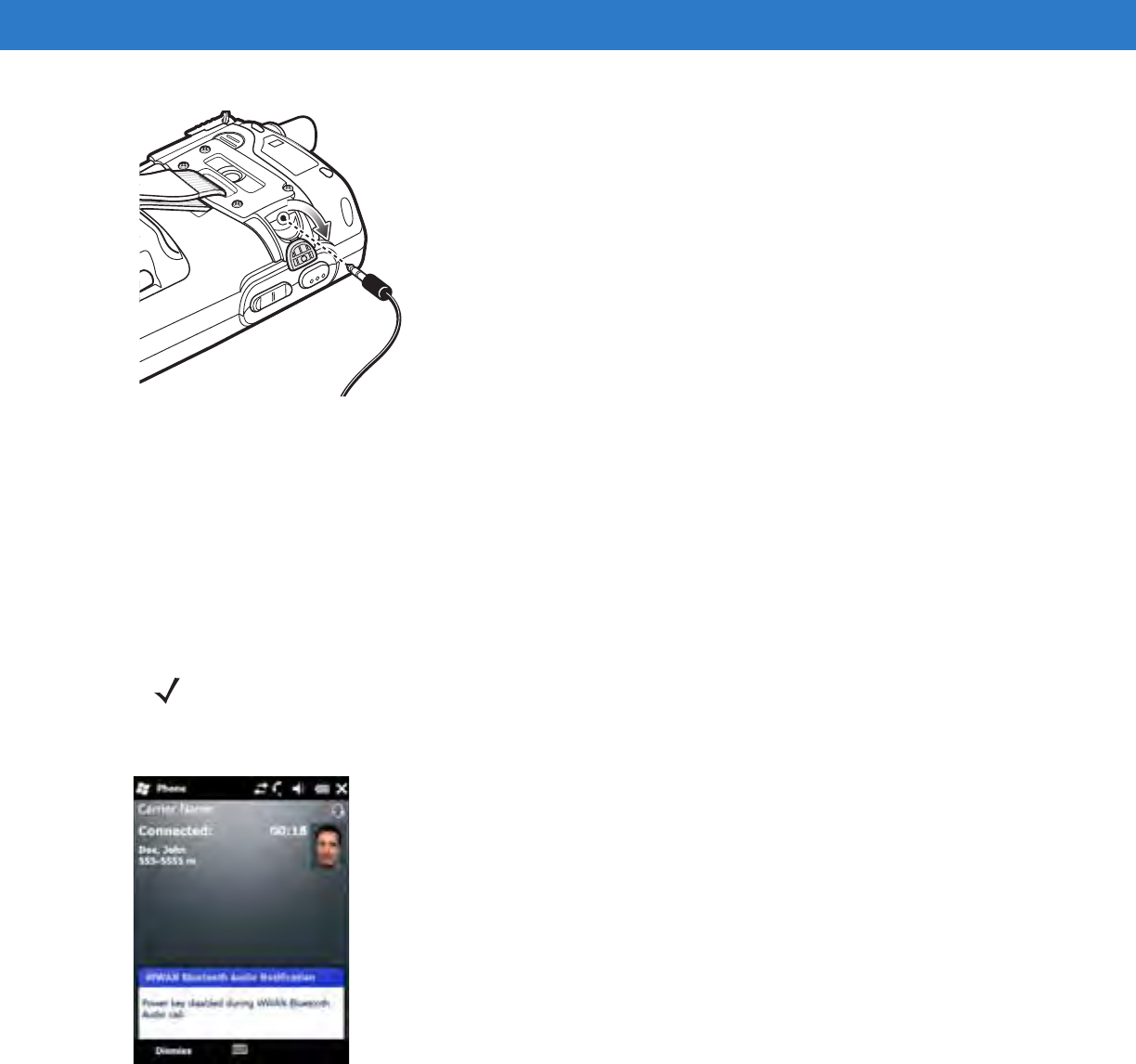
4 - 4 MC75A Enterprise Digital Assistant User Guide
Figure 4-4
Using a Headset
Using a Bluetooth Headset
You can use a Bluetooth headset for audio communication when using an audio-enabled application. See Chapter
6, Using Bluetooth for information on connecting a Bluetooth headset to the MC75A. Set the MC75A’s volume
appropriately before putting the headset on. When a Bluetooth headset is connected the speakerphone is muted.
It is recommended for phone conversations to use the Bluetooth Hands-free profile instead of the Headset profile.
See Chapter 6, Using Bluetooth for more information.
The following dialog box displays when a Bluetooth headset connection is established.
Figure 4-5
WWAN Bluetooth Audio Notification Dialog Box
Adjusting Audio Volume
Use the Volume Control Slider or the keypad keys to adjust the volume of the ringer when not in a call and the
audio volume when in a call.
NOTE When using a Bluetooth headset during a call, the MC75A power button is disabled and the MC75A will not
go into suspend mode. Once the call is completed, the power button functionality is enabled.
DRAFT
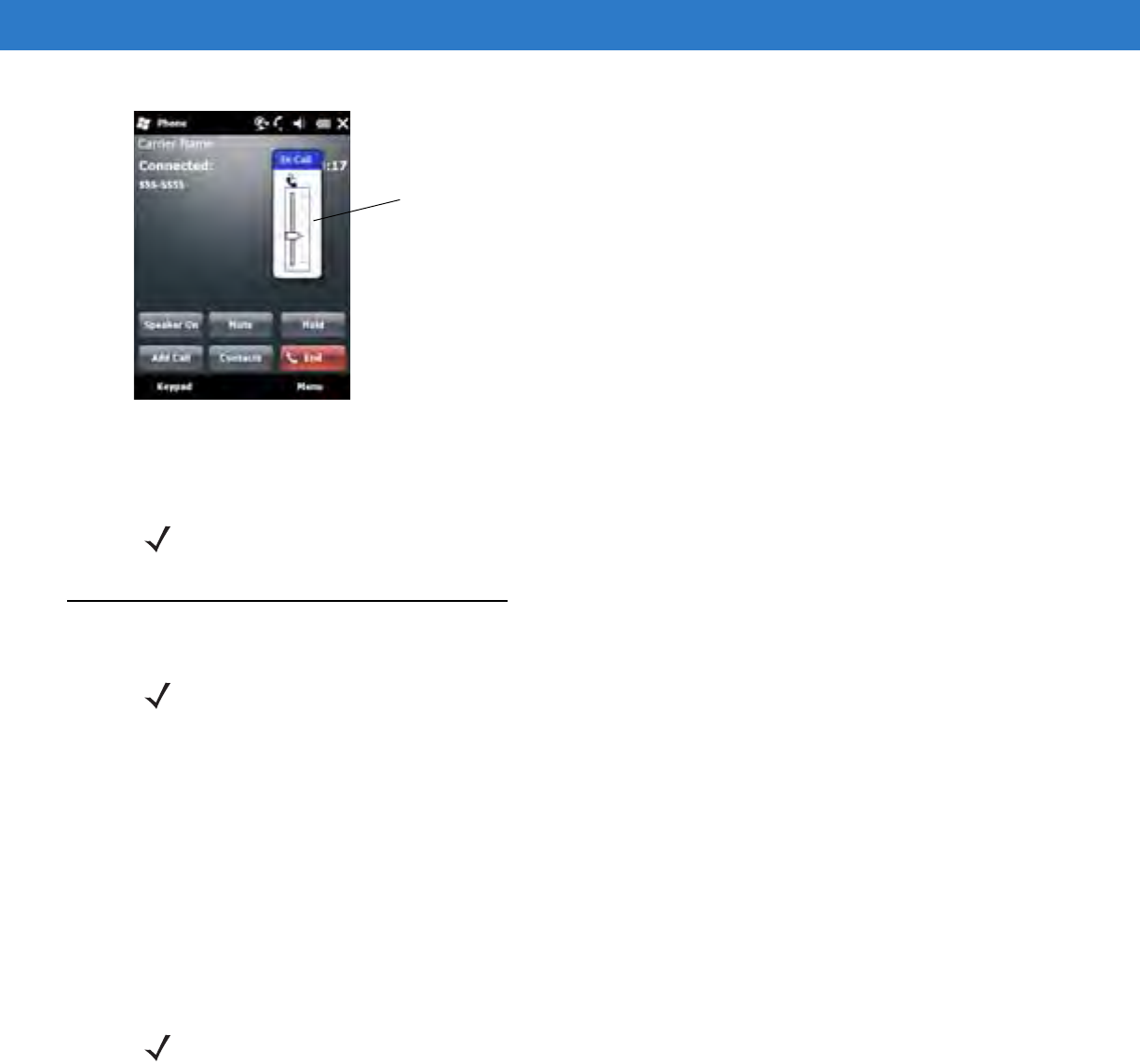
Using the Phone 4 - 5
Figure 4-6
Phone Volume Slider
To adjust the volume tap the Speaker icon in the Title bar. Move the slider up or down to adjust the volume.
Making a Call
With the MC75A, you can make a call from the phone dialer, contacts, speed dial and call history.
Using the Phone Dialer
To make a call using the phone keypad:
1. Tap Start > Phone or press the green phone key on the MC75A’s keypad.
2. From the Phone keypad, tap the number to call.
3. Tap Talk.
4. Tap End to stop dialing or end the call.
Using Contacts
Use Contacts to make a call without looking up or entering the phone number.
To make a call from Contacts:
1. Tap Start > Contacts.
2. From the contact list, tap and hold the contact name.
Phone Volume Slider
NOTE Adjust the conversation phone volume during a call. Adjusting the volume while not in a call affects the ring
and notification sound levels.
NOTE You can make emergency calls even when the MC75A is locked or when a SIM card is not installed. See
Making an Emergency Call on page 4-7 for more information.
NOTE Alternatively, use the green and red phone keys on the MC75A keypad to dial (green) and end (red) calls.
If you tap a wrong number, tap Delete key to erase each subsequent digit of a number. To erase the entire
number, tap and hold the Delete key.
DRAFT
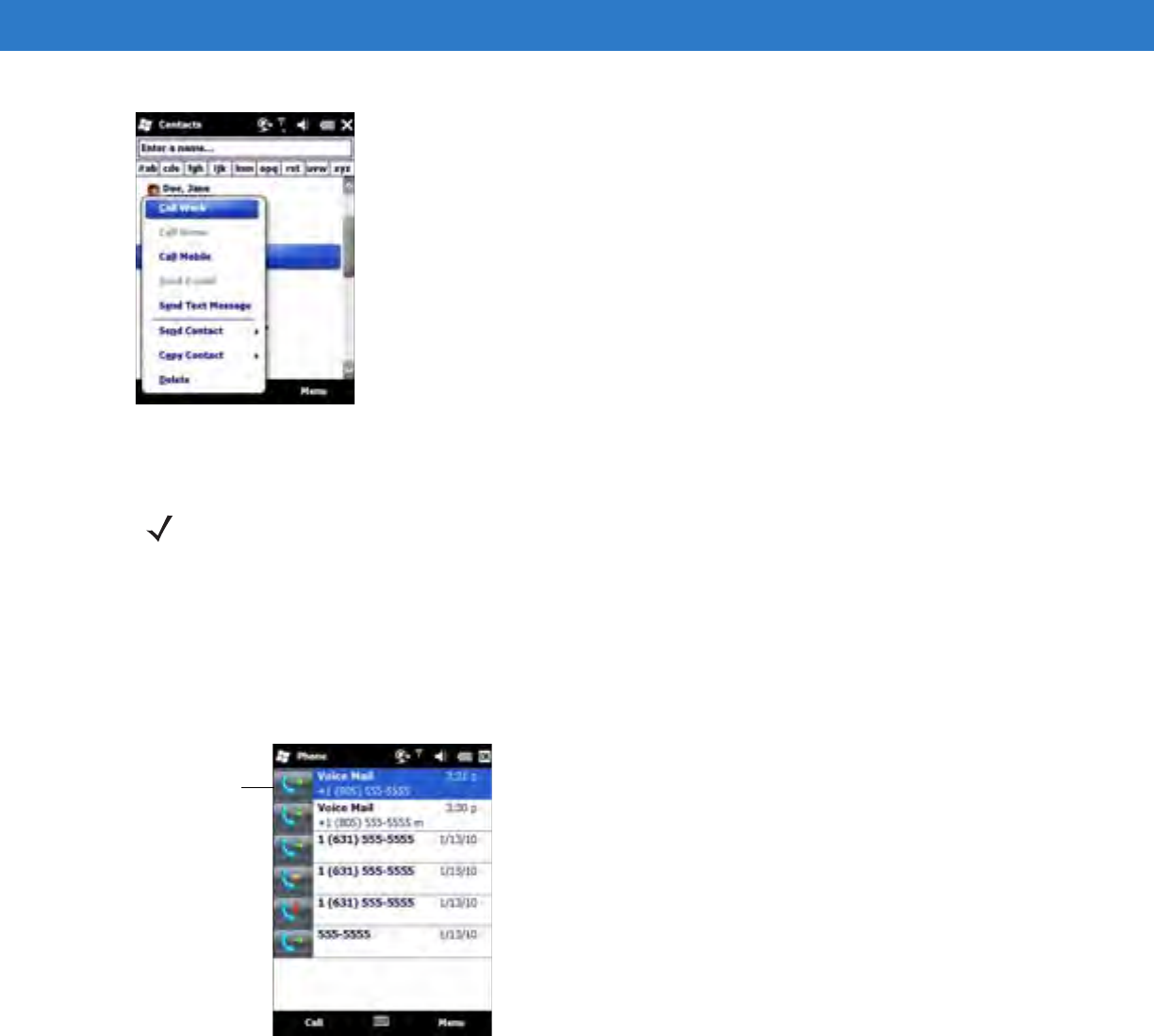
4 - 6 MC75A Enterprise Digital Assistant User Guide
Figure 4-7
Contacts Menu
3. Tap Call Work, Call Home or Call Mobile.
Using Call History
To make a call using Call History:
1. Tap Start > Phone or press the green phone key on the MC75A’s keypad.
2. From the Phone keypad, tap Call History.
Figure 4-8
Call History Window
3. Tap the phone icon next to the number to begin dialing and return to the phone keypad.
4. Tap End or press the red phone key on the MC75A keypad to stop dialing or end the call.
Making a Speed Dial Call
Use Speed Dial to call someone saved in the speed dial directory.
To make a speed dial call:
1. Tap Start > Phone or press the green phone key on the MC75A’s keypad.
NOTE To make a call from an open contact, tap the number to call. See On-Device Help for more information about
Contacts.
Phone icon
DRAFT
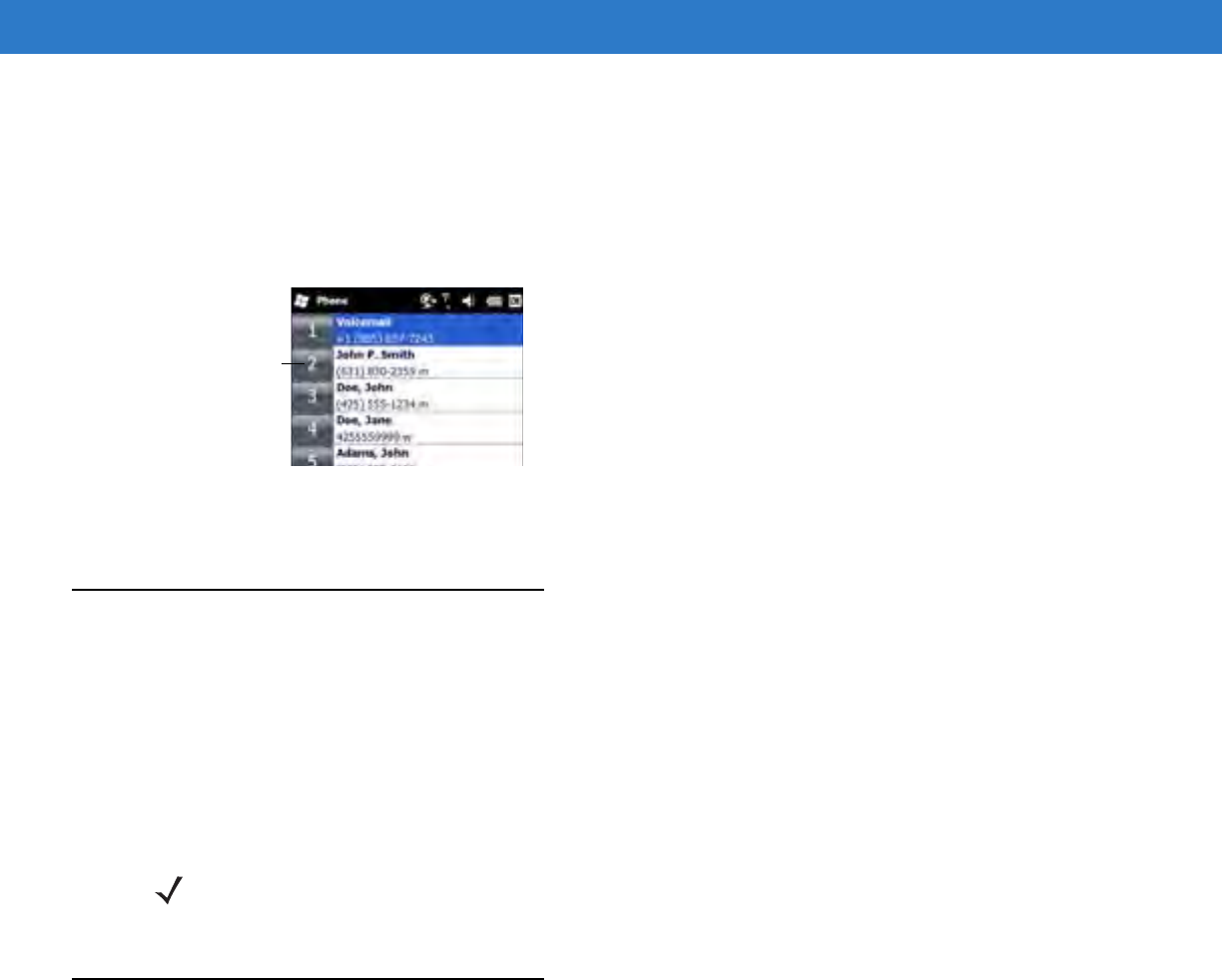
Using the Phone 4 - 7
2. From the Phone keypad, tap and hold the speed dial location number assigned to a contact. (To dial a one-digit
speed dial location number, tap and hold the speed dial number. To dial a two-digit speed dial location number,
tap the first digit and then tap and hold the second digit.)
or
From the Phone keypad, tap Speed Dial and tap the speed dial location number of the desired contact in the
list.
Figure 4-9
Speed Dial Contact List
3. To stop dialing or end the call, tap End or press the red phone key on the MC75A keypad.
Making an Emergency Call
Your service provider programs one or more emergency phone numbers, such as 911 or 999, that you can call
under any circumstances, even when your phone is locked or the SIM card is not inserted (on MC75A6). Your
service provider can program additional emergency numbers into your SIM card. However, your SIM card must be
inserted in your phone in order to use the numbers stored on it. See your service provider for additional
information. See Installing the SIM Card on page 1-3 for SIM card installation procedures.
When the alpha-numeric keypad phone is locked, press the Orange key twice to set the keypad to numeric mode
and then enter the emergency number.
Answering a Call
A dialog box appears on the MC75A when it receives an incoming call. If the phone is set to ring, a ring tone
sounds. Answer or ignore the incoming call.
To answer an incoming call tap Answer on the Phone - Incoming dialog or press the green phone key on the
MC75A keypad.
Speed Dial
Location Number
NOTE Emergency numbers vary by country. Your phone’s pre-programmed emergency number(s) may not work in
all locations, and sometimes an emergency call cannot be placed due to network, environmental, or
interference issues.
DRAFT
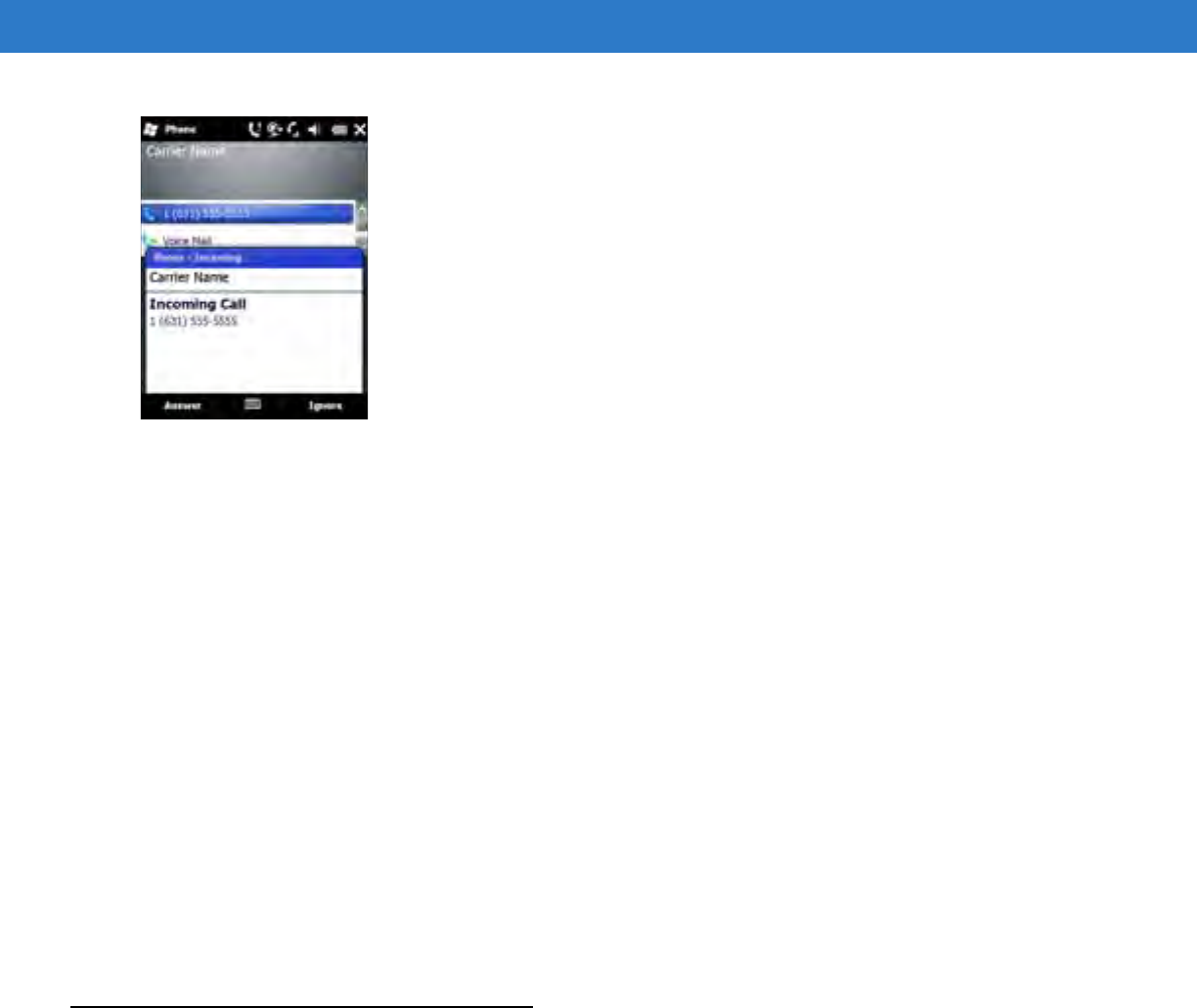
4 - 8 MC75A Enterprise Digital Assistant User Guide
Figure 4-10
Incoming Call
To ignore the incoming call tap Ignore. This may send the caller to voice mail, depending on the service provider.
Otherwise, this presents busy signal to the calling party.
To end the call tap End or press the red phone key on the MC75A keypad.
Incoming Call Features
•
If you receive a call while in a call, tap Wait to place the call in call waiting.
•
You can use other programs on the MC75A during a call. To switch back to Phone, tap Talk or tap Start >
Phone. Tap End to end the call.
•
If a caller isn't in your contact list, create a contact during the call or from Call History by tapping Menu >
Save to Contacts.
•
To terminate a call when a second call comes in and answer the waiting call, tap End on the Phone keypad to
disconnect the active call, then tap Answer or press the Send key to answer the waiting call.
•
To hold the current call and answer a waiting call, tap Answer or press the Send key to place the current call
on hold and answer the incoming call.
•
To put a call on hold to call another number or answer an incoming call, tap Hold on an MC75A6 or Talk on
an MC75A8. To move from one call to another, tap Swap on an MC75A6 or Talk on an MC75A8.
Smart Dialing
Smart Dialing makes it easy to dial a phone number. When you start entering numbers or characters, Smart Dialing
automatically searches and sorts the contact entries on the SIM card, in Contacts, and the phone numbers in Call
History (including incoming, outgoing, and missed calls). You can then select the desired number or contact from
the filtered list to dial.
Open the Phone screen, then tap the keys on the Phone keypad that correspond to the phone number or contact to
call. The contact panel lists contacts that match the sequence that you entered.
Smart Dialing starts looking for numbers or contacts that match the sequence entered.
To find a phone number:
•
Enter the first one or two digits to find a phone number in Call History.
•
Enter the first three digits or more to find a phone number from the saved Contacts and SIM card.
DRAFT
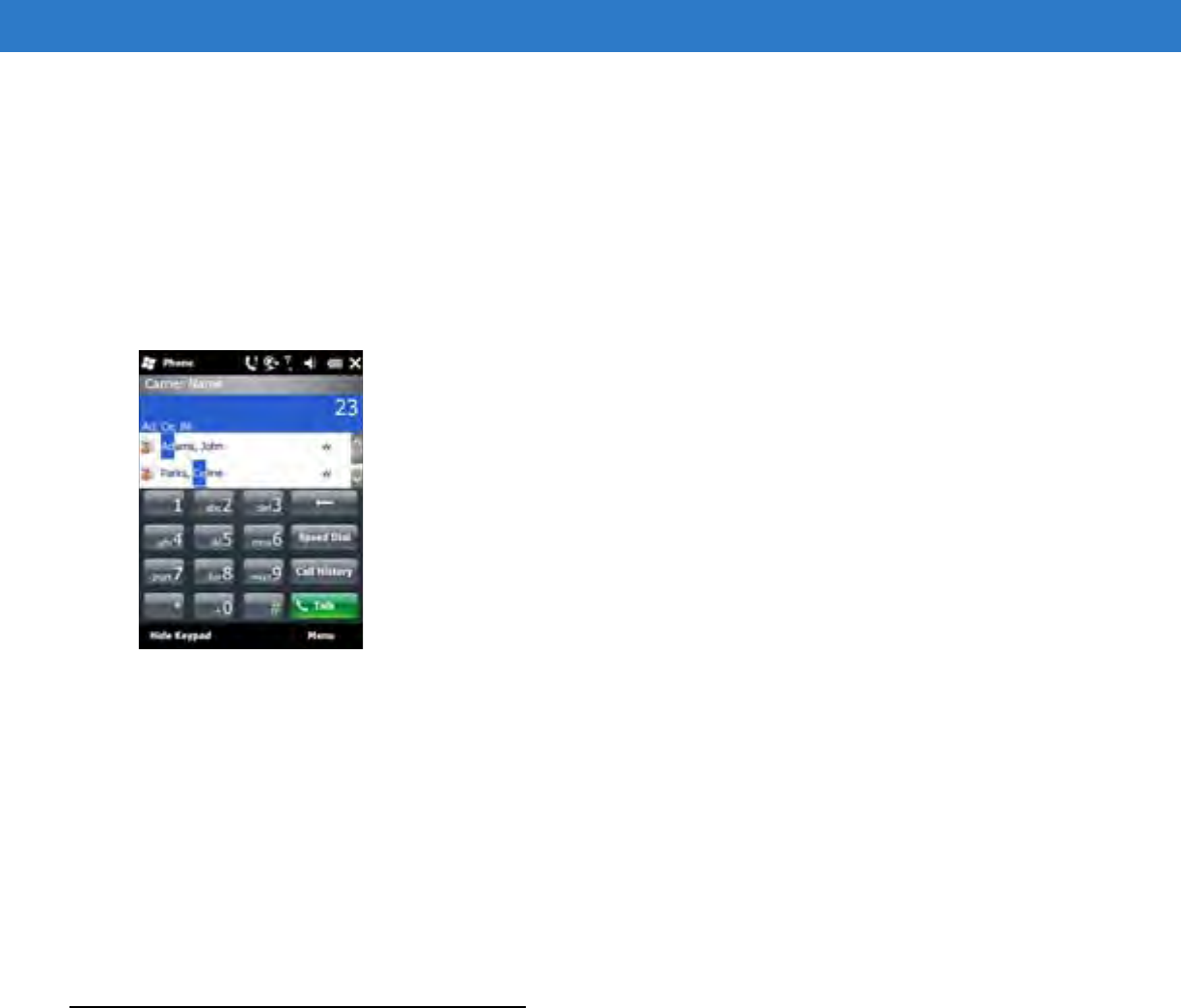
Using the Phone 4 - 9
To find a contact name:
•Enter the first letter of a contact’s first name or last name. Smart Dialing searches for the letter starting
from the first character of a contact name as well as from the character that appears after a space, dash,
or underscore in a contact name. For example, if you tap number “2” which is associated with [a, b, c] on
the Phone keypad, contact names such as the following will be considered matches: “Smith, Bernard”,
“Adams, John”, “Carlson, Eileen”, “Dillon, Albert”, “Childs, Larry”, “Cooper, Robert” and “Parks, Celine”.
•If the matching list is long narrow down the search further by entering another letter. Using the same
example above, tap “3” which is associated with (d, e, f), the matching list is narrowed down to the
following names: “Smith, Bernard”, “Adams, John”, and “Parks, Celine”.
Figure 4-11
Finding a Contact
To make a call or send a text message using Smart Dialing:
1. Begin entering the first few numbers or characters.
2. In the Smart Dialing panel, use the up and down arrows on the keypad to navigate to the desired contact or
phone number.
3. When the correct contact is selected, press TALK to make a voice call.
4. To send a text message to the selected contact, tap Menu > Send Text Message.
5. To call a different phone number associated with the selected contact, tap the contact name and select the
phone number to call.
Muting a Call
During a call, you can mute the microphone so you can hear the person on the line but he or she cannot hear
conversation from the microphone. This is useful when there is conversation or background noise on your end.
To mute or unmute a call:
1. Tap Start > Phone or press the green phone key on the MC75A’s keypad.
2. Make a call.
3. Tap Mute on the display to mute the audio. The Mute icon appears.
DRAFT
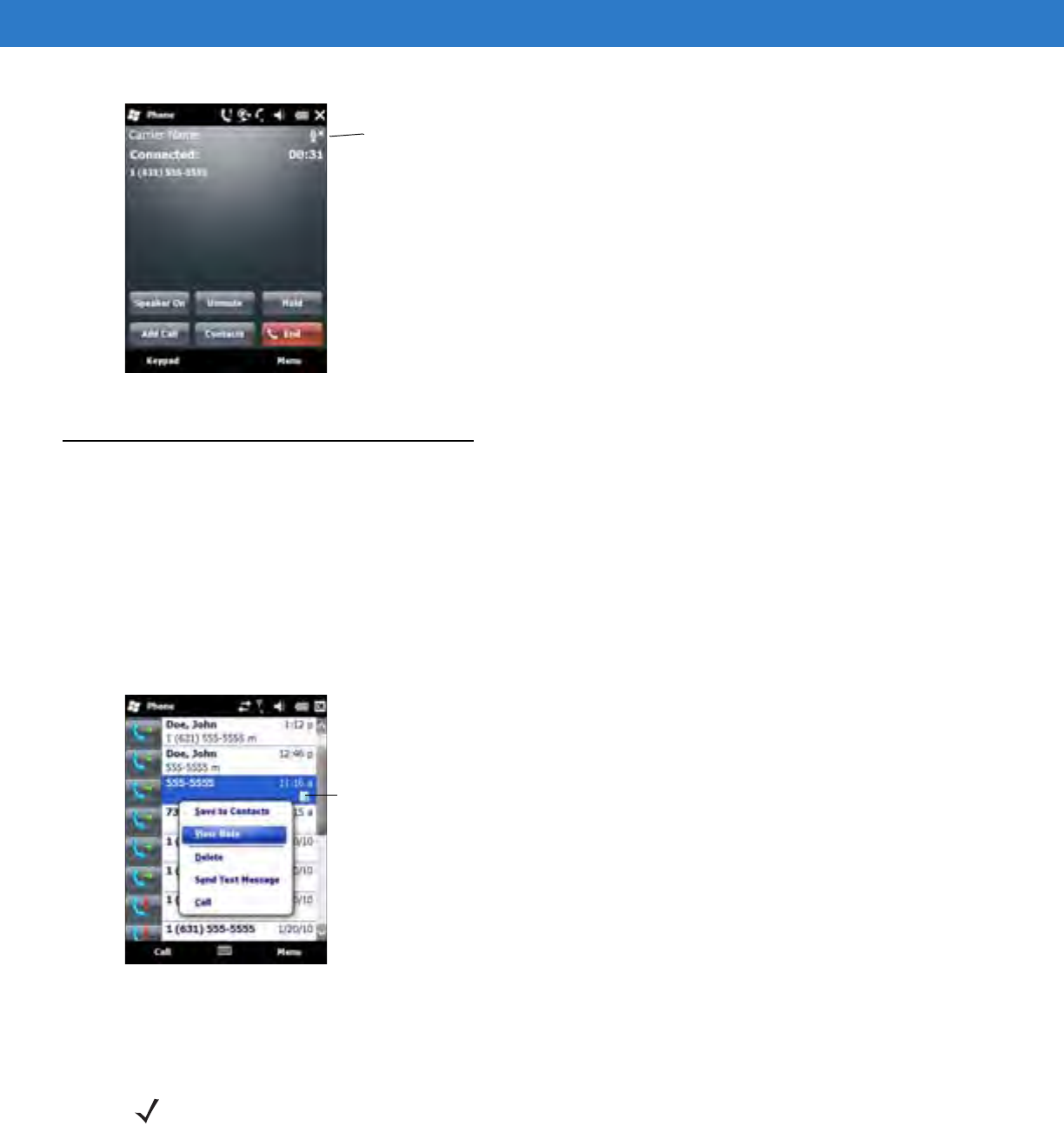
4 - 10 MC75A Enterprise Digital Assistant User Guide
Figure 4-12
Mute Button and Icon
Taking N otes
To create a note during a call, tap Note on the display, then enter the note. For more information about creating
notes see the Windows On-Device Help.
To access a note created during a call:
1. Tap Start > Phone or press the green phone key on the MC75A’s keypad.
2. From the Phone keypad, tap Call History.
3. Tap and hold the number or the Note icon for the phone call entry containing the note.
Figure 4-13
Call History - Notes Menu
4. Tap View Note.
5. Tap OK to exit.
Mute Icon
Note icon
NOTE Also access notes directly from the Notes application by tapping Start > Notes.
DRAFT
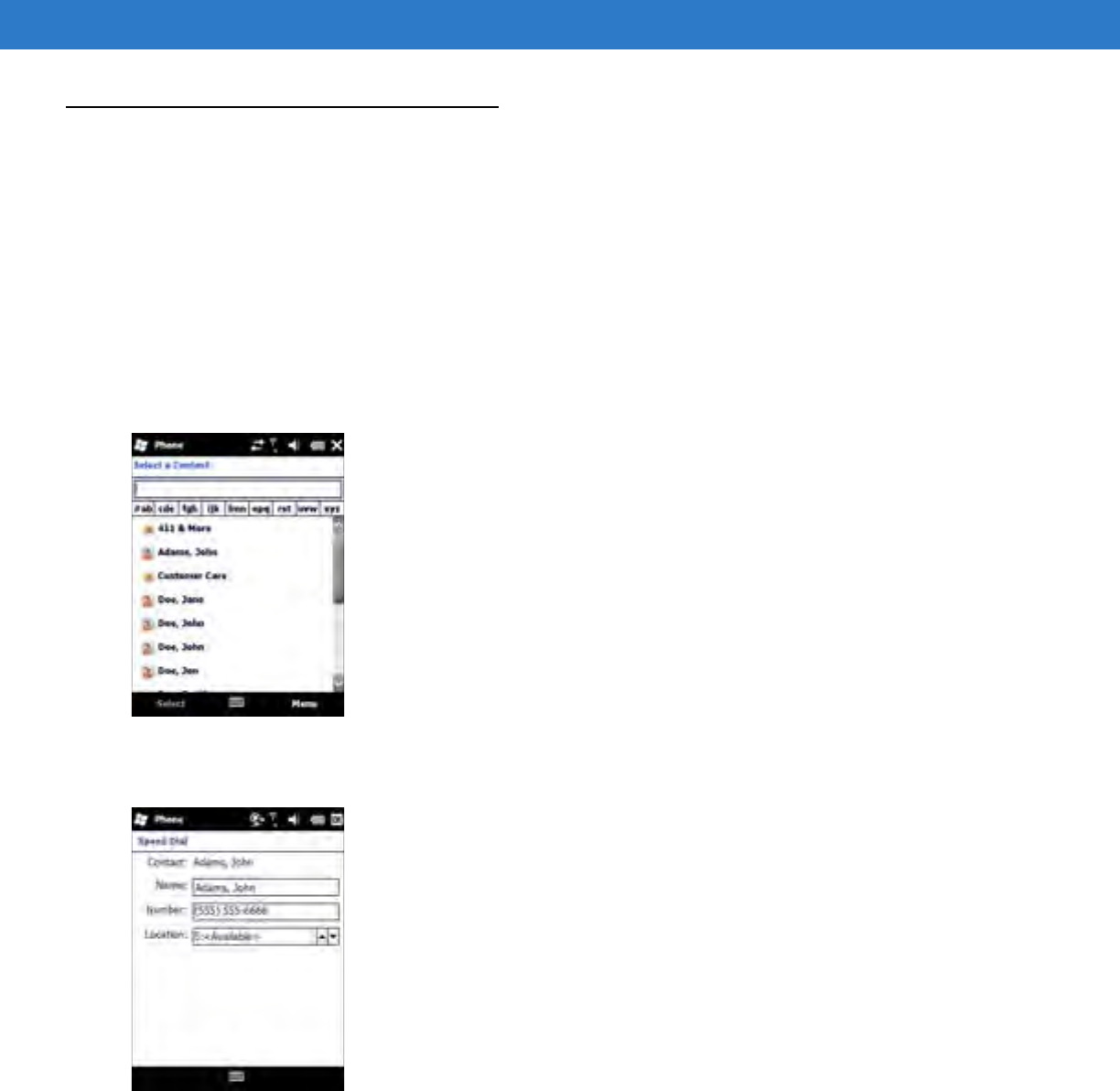
Using the Phone 4 - 11
Using Speed Dial
Create speed dial numbers to dial frequently called numbers with a single tap. Before creating a speed dial entry,
ensure the phone number exists in Contacts.
Adding a Speed Dial Entry
To add a speed dial entry from the phone keypad:
1. Ensure the contact and phone number are in the Contacts list.
2. Tap Start > Phone or press the green phone key on the MC75A’s keypad.
3. Tap Speed Dial button > Menu > New.
Figure 4-14
Contacts
4. Tap the desired contact name and number in the list.
Figure 4-15
Speed Dial Contact Location
5. In the Location field, tap the up/down arrows to select an available location to assign as the new speed dial
entry. The first speed dial location is reserved for voice mail.
6. Tap OK to add the contact to the speed dial list.
DRAFT
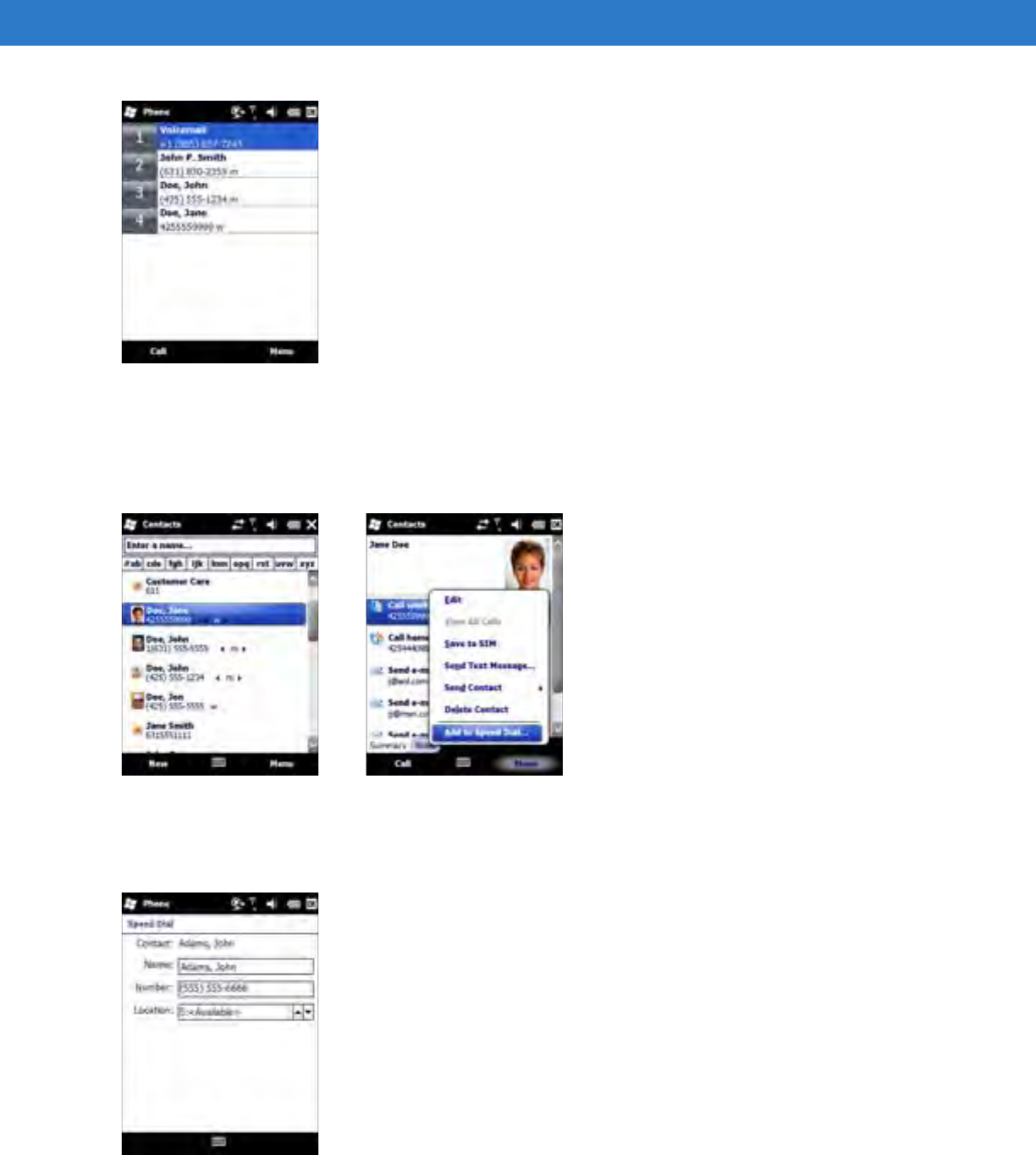
4 - 12 MC75A Enterprise Digital Assistant User Guide
Figure 4-16
Speed Dial Contact List
7. Tap OK to exit the Speed Dial Contact List.
To add a speed dial entry from the Contacts window:
1. Tap Start > Contacts.
Figure 4-17
Contacts
2. Tap a contact name.
3. Tap Menu > Add to Speed Dial.
Figure 4-18
Speed Dial Contact Location
DRAFT
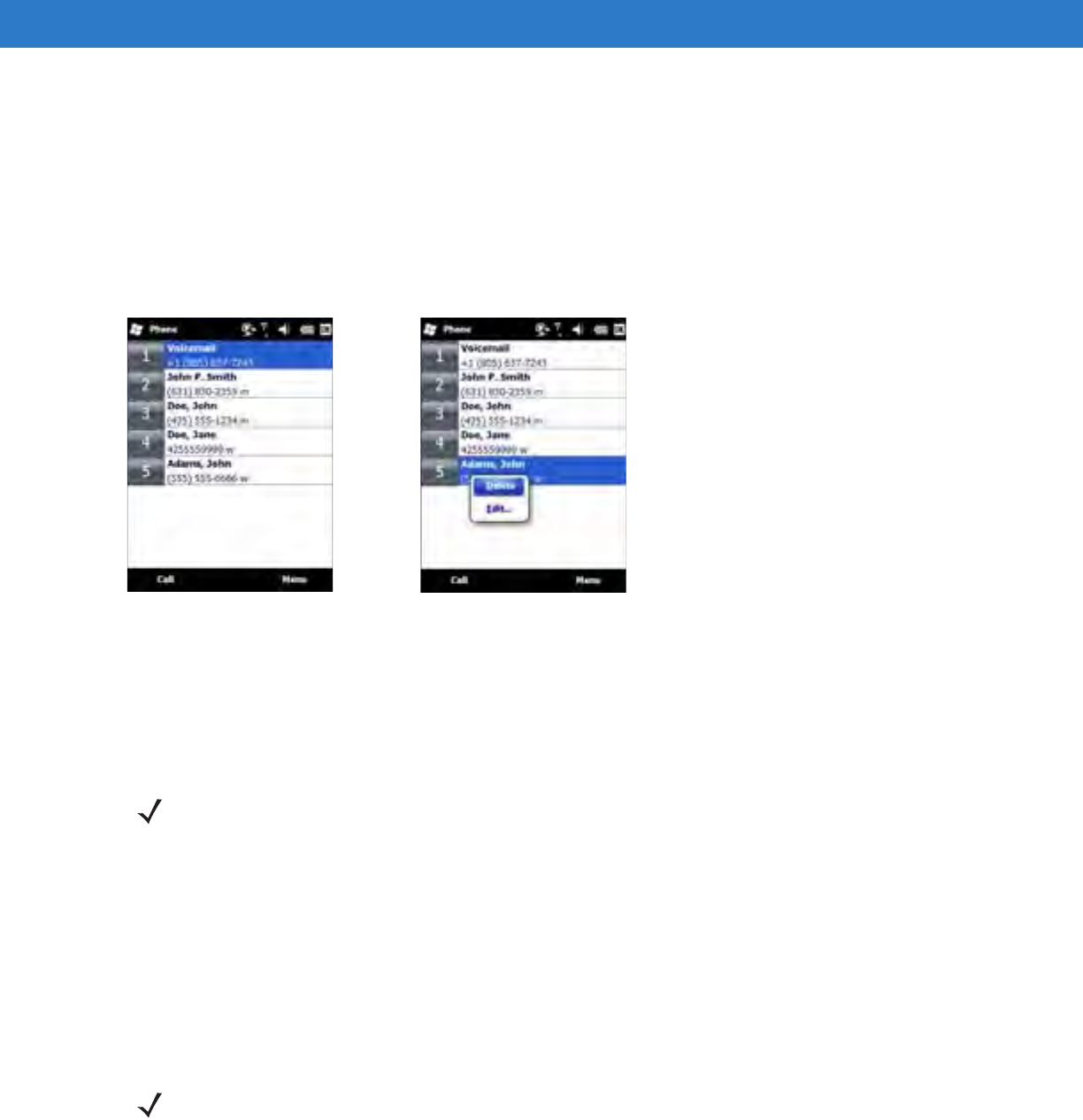
Using the Phone 4 - 13
4. Tap the up/down arrows to select an available location to assign as the new speed dial entry. The first speed
dial location is reserved for voice mail.
5. Tap OK.
Editing a Speed Dial Entry
1. Tap Start > Phone or press the green phone key on the MC75A’s keypad.
2. Tap Speed Dial button.
Figure 4-19
Speed Dial Contact List
3. Tap and hold the contact name.
4. Tap Edit... .
5. Change the name, phone number, or location information.
6. Tap OK.
Deleting a Speed Dial Entry
1. Tap Start > Phone or press the green phone key on the MC75A’s keypad.
2. Tap Speed Dial button.
3. Tap and hold the contact name.
4. Tap Delete.
5. Tap Yes to confirm permanently deleting the speed dial entry.
NOTE Editing names and phone numbers in Speed Dial does not alter contact information in Contacts (Start
> Contacts).
NOTE Deleting names and phone numbers in Speed Dial does not delete the contact information in Contacts (Start
> Contacts).
DRAFT
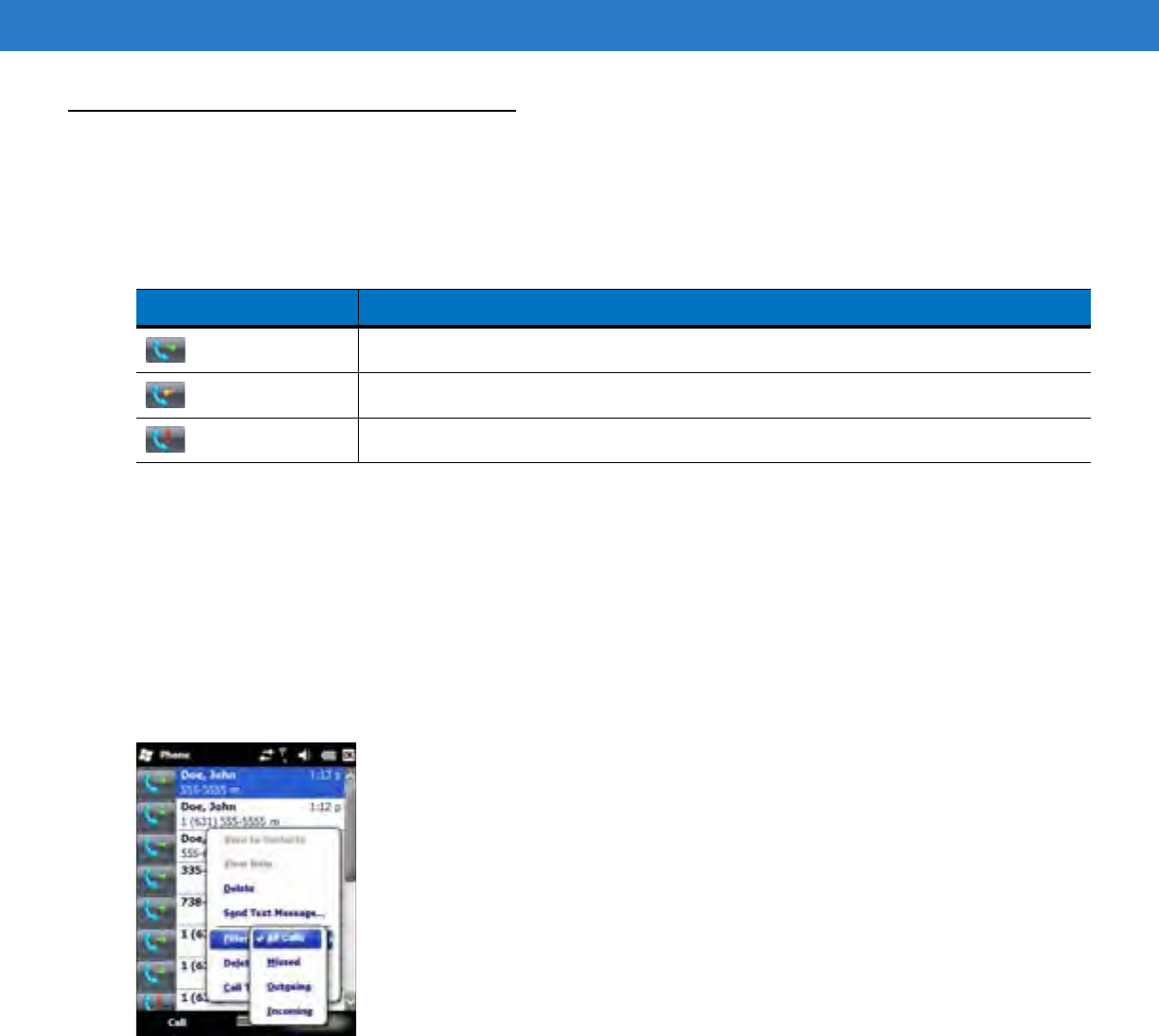
4 - 14 MC75A Enterprise Digital Assistant User Guide
Using Call History
Use Call History to call someone who was recently called, or recently called in. Call History provides the time and
duration of all incoming, outgoing, and missed calls. It also provides a summary of total calls and easy access to
notes taken during a call. Table 4-1 lists the call history icons that appear in the Call History window.
Managing Call History
Change views, reset the call timer, and delete calls to manage the calls stored in Call History.
Changing the Call History View
1. Tap Start > Phone or press the green phone key on the MC75A’s keypad to display the Phone keypad.
2. From the Phone keypad, tap Call History.
3. Tap Menu > Filter to show the menu.
Figure 4-20
Call History - All Calls/Show Menu
4. Select a view type from the menu to display only missed calls, outgoing calls, incoming calls, or calls listed
alphabetically by caller name.
5. Tap OK to exit the Call History window.
Resetting the Recent Calls Counter
1. Tap Start > Phone or press the green phone key on the MC75A’s keypad to display the Phone keypad.
2. From the Phone keypad, tap Call History.
3. Tap Menu.
Table 4-1
Call History Icons
Icon Description
This icon appears next to the contact information for all outgoing calls.
This icon appears next to the contact information for all incoming calls.
This icon appears next to the contact information for all missed calls.
DRAFT
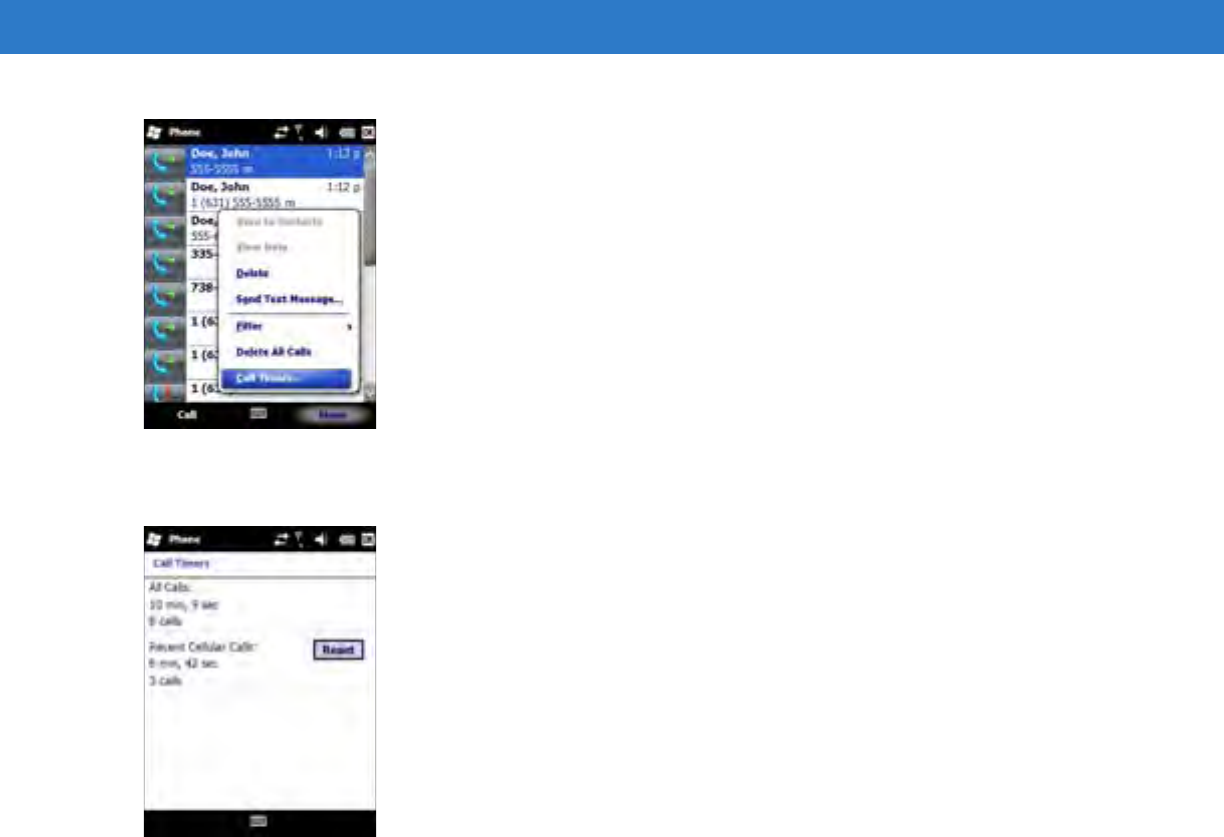
Using the Phone 4 - 15
Figure 4-21
Call History - Tools Menu
4. Select Call Timers... .
Figure 4-22
Call History - Call Timers
5. Tap Reset. (The All Calls: counter cannot be reset.)
6. Tap OK to exit the Call Timers window.
Deleting All Call History Items
1. Tap Start > Phone or press the green phone key on the MC75A’s keypad to display the Phone keypad.
2. From the Phone keypad, tap Call History.
3. Tap Menu.
DRAFT
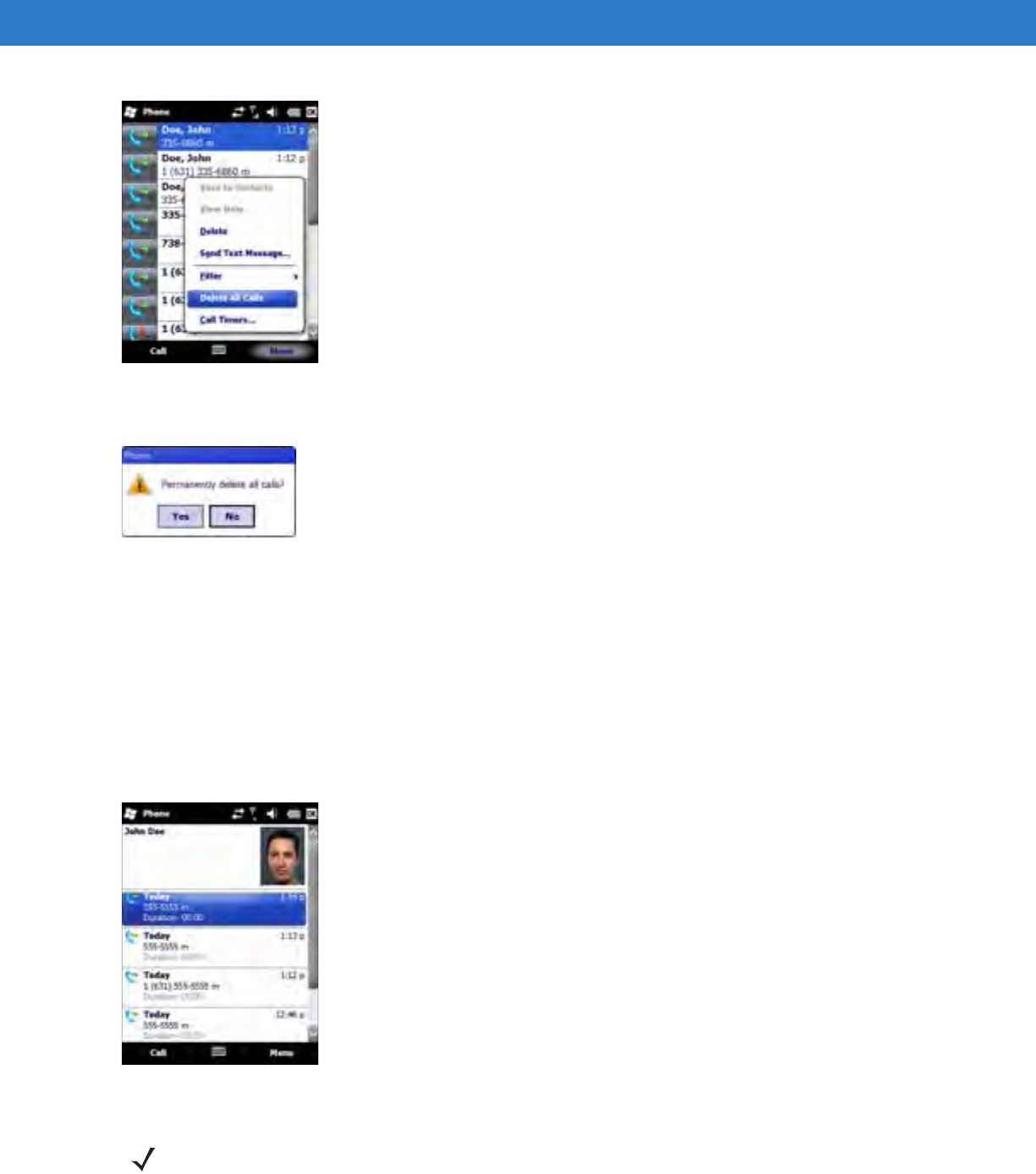
4 - 16 MC75A Enterprise Digital Assistant User Guide
Figure 4-23
Call History - Tools Menu
4. Select Delete all calls.
Figure 4-24
Call History - Delete All Dialog
5. Tap Yes.
6. Tap OK to exit the Call History window.
Viewing Call Status
1. Tap Start > Phone or press the green phone key on the MC75A’s keypad to display the Phone keypad.
2. From the Phone keypad, tap Call History.
3. Tap an entry. The Call Status window appears.
Figure 4-25
Call History - Detail
NOTE When more than one call is on the phone line, only the duration of the first call is recorded.
DRAFT
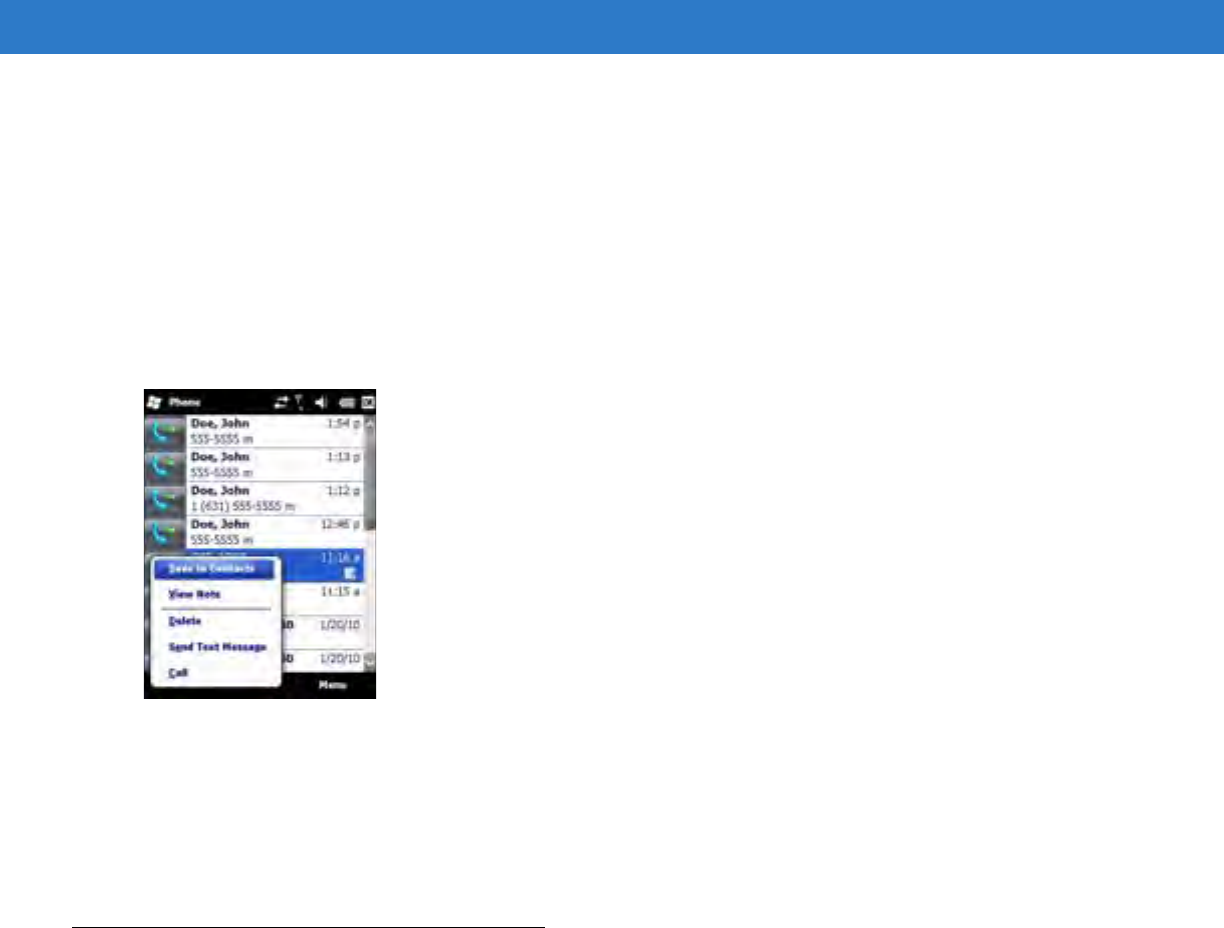
Using the Phone 4 - 17
4. Tap OK and then OK to exit.
Using the Call History Menu
Use the Call History menu to dial voice mail, access the Activation Wizard, save to contacts, view a note, delete a
listing, send a text message, and make a call.
1. Tap Start > Phone or press the green phone key on the MC75A’s keypad to display the Phone keypad.
2. From the Phone keypad, tap Call History.
3. Tap and hold an item in the list.
Figure 4-26
Call History - Menu
4. Select an applicable item from the menu, as needed.
5. Depending on the item selected, the appropriate window displays. For example, select Send Text Message to
display the Inbox window.
6. Tap OK to exit the Call History window.
Swapping Calls on an MC75A6
To move between two phone calls:
1. Tap Start > Phone or press the green phone key on the MC75A’s keypad to display the Phone keypad.
2. Enter the first phone number and press Talk. When the call connects, Hold appears on the keypad.
DRAFT
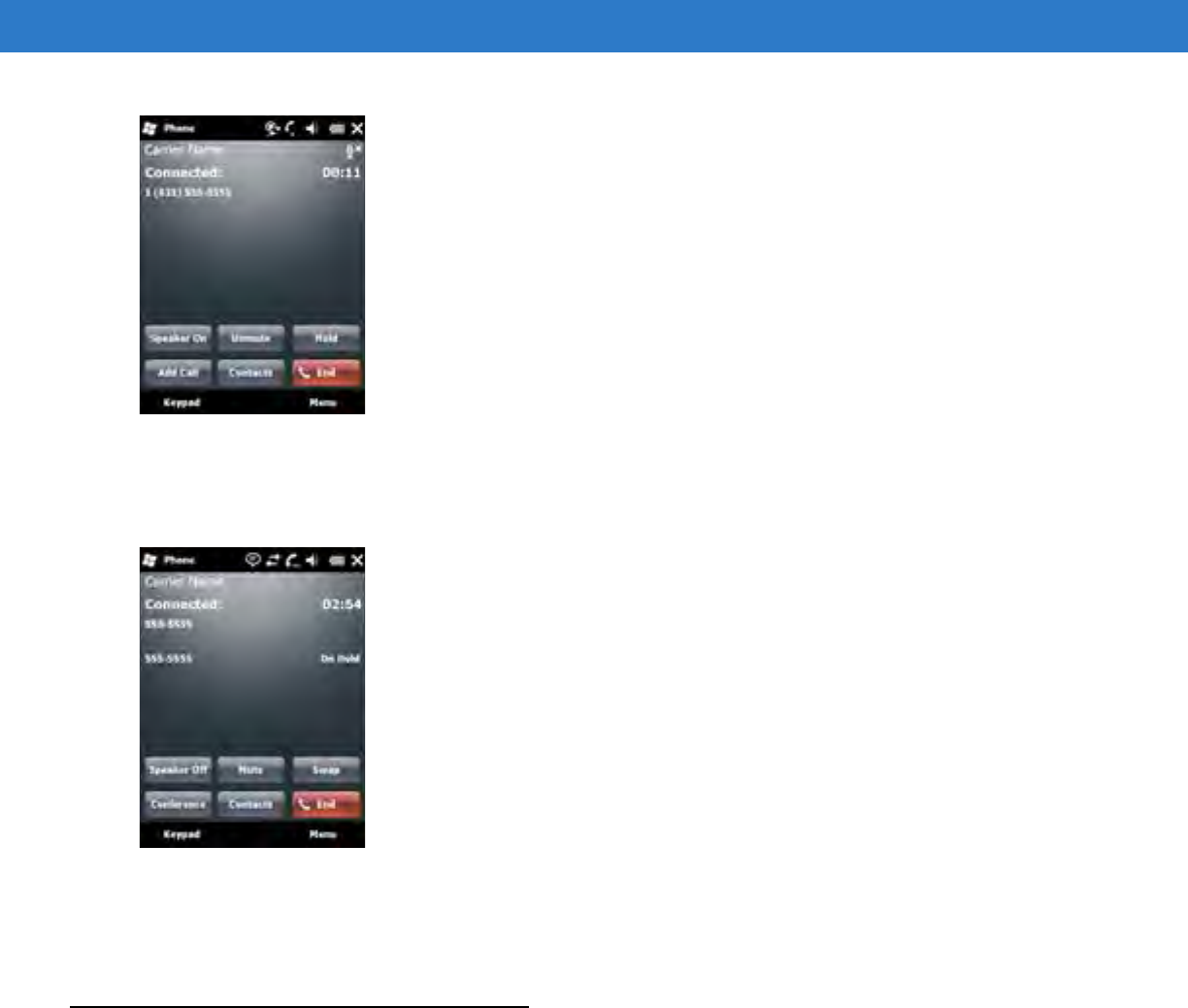
4 - 18 MC75A Enterprise Digital Assistant User Guide
Figure 4-27
Call Swapping - Hold
3. Tap Hold on to place the first number on hold.
4. Enter the second number and tap Talk.
Figure 4-28
Call Conferencing - Conferencing
5. Tap Swap to move from one call to the other.
6. Tap End or press the red phone key on the MC75A keypad to end each call.
Swapping Calls on an MC75A8
To swap between two incoming phone calls:
1. Tap Answer to connect to the first call.
DRAFT
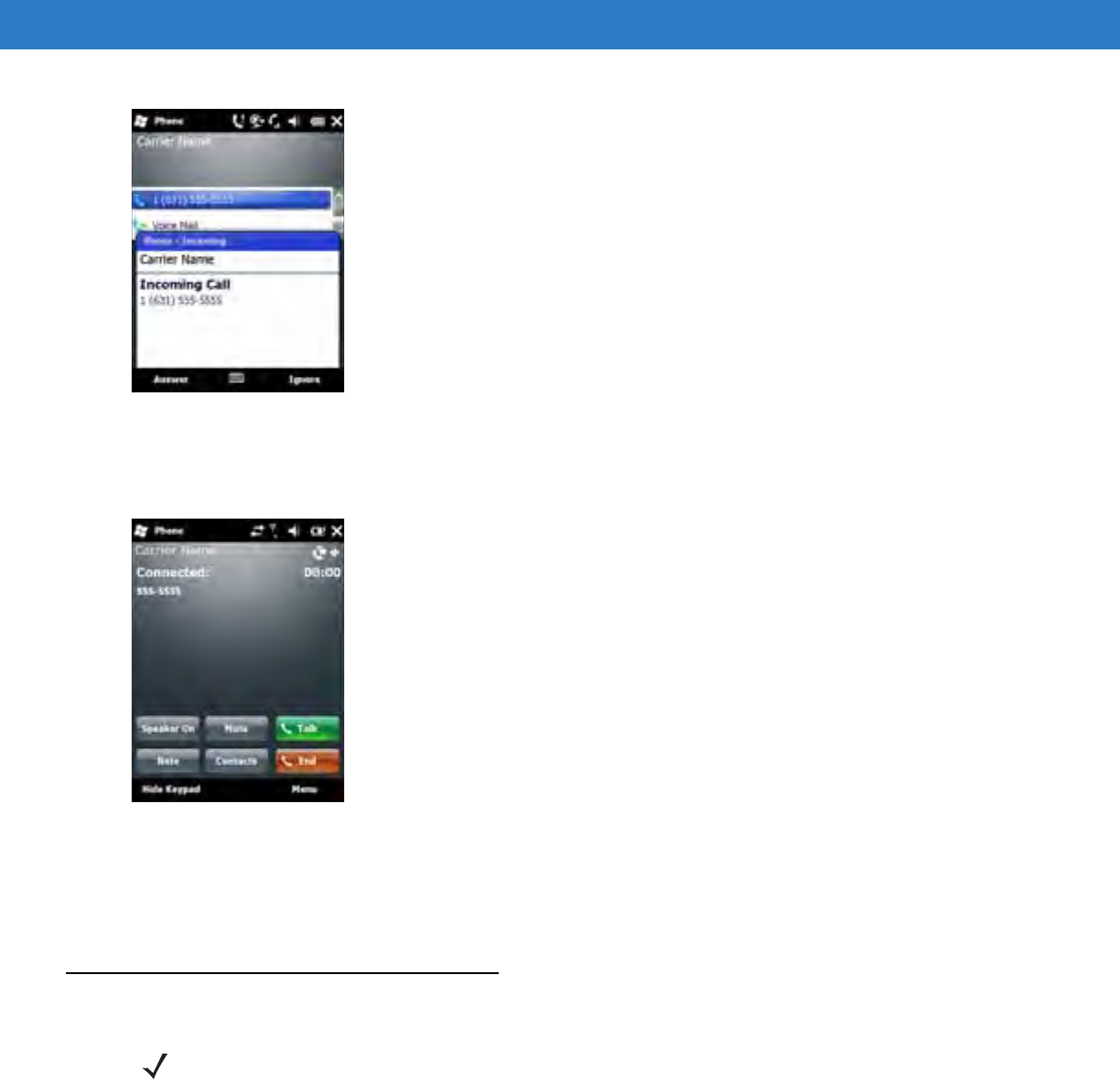
Using the Phone 4 - 19
Figure 4-29
Answer a Call
2. When a second call arrives, tap Answer. The first call is placed on hold.
3. Tap Talk to swap from one call to the other.
Figure 4-30
Call Swapping
4. Tap End or press the red phone key on the MC75A keypad to end active call. The remaining call re-connects,
tap Answer to connect to the call.
5. Tap End or press the red phone key on the MC75A keypad to end the last call.
Conference Calling on an MC75A6
To create a conference phone session with multiple people:
1. Tap Start > Phone or press the green phone key on the MC75A’s keypad to display the Phone keypad.
2. Enter the first phone number and press Talk. When the call connects, Hold appears on the keypad.
NOTE Conference Calling and the number of conference calls allowed may not be available on all services. Please
check with your service provider for Conference Calling availability.
DRAFT
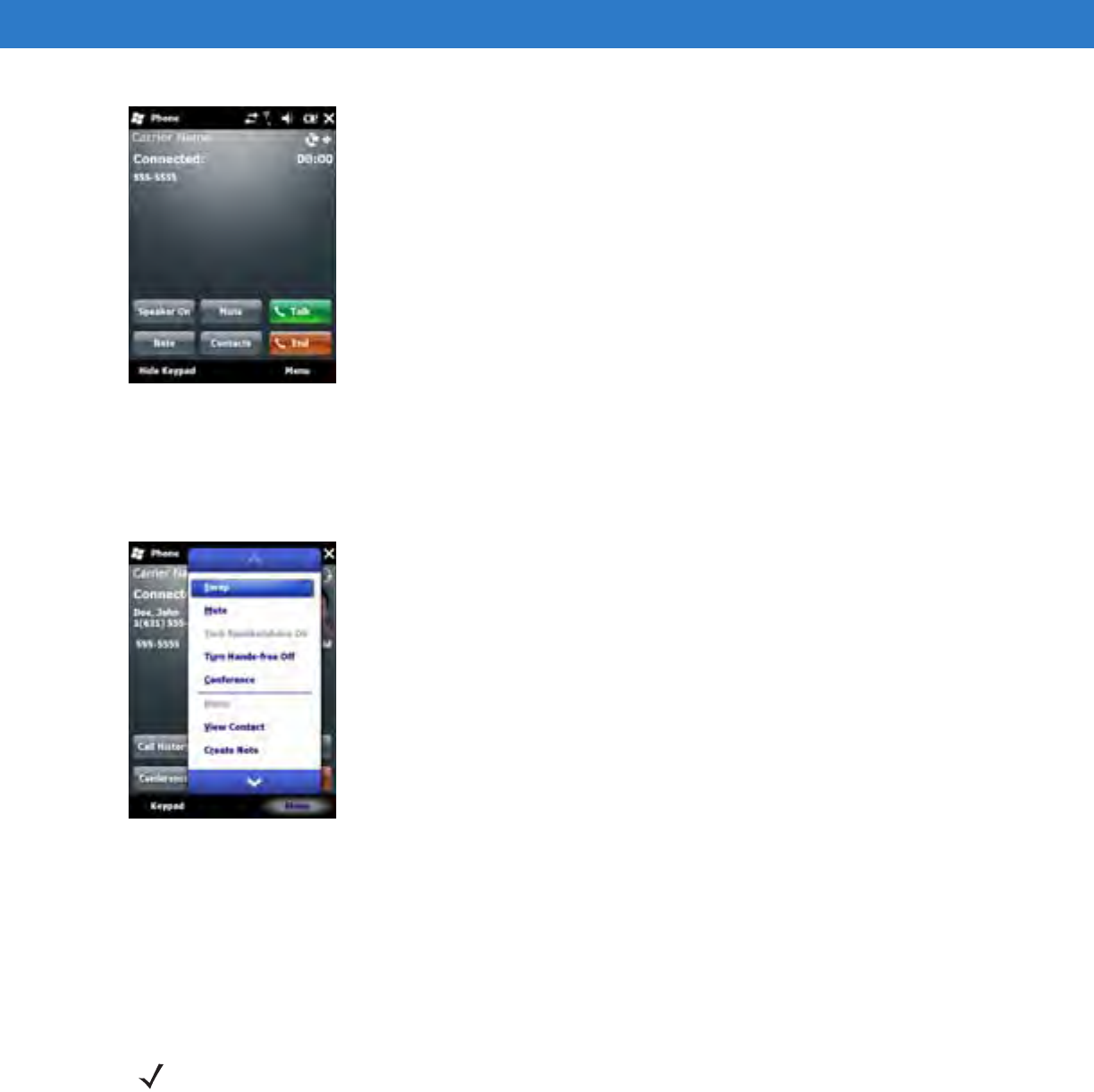
4 - 20 MC75A Enterprise Digital Assistant User Guide
Figure 4-31
Conference Call - Hold
3. Tap Hold to place the first call on hold.
4. Enter the second phone number and tap Talk.
5. After the call is answered, tap Menu > Conference to place the calls in conference mode.
Figure 4-32
Creating a Conference Call
6. Tap Hold to place the conference on hold.
7. Enter another phone number and tap Talk.
8. After the call is answered, tap Menu > Conference to place all the calls in conference mode.
9. Repeat steps 6 through 8 for up to six phone numbers.
10. Ta p End or press the red phone key on the MC75A keypad to end the conference call.
NOTE To speak privately with one party during a conference call, tap Menu > Private. To include all parties again,
tap Menu > Conference.
DRAFT
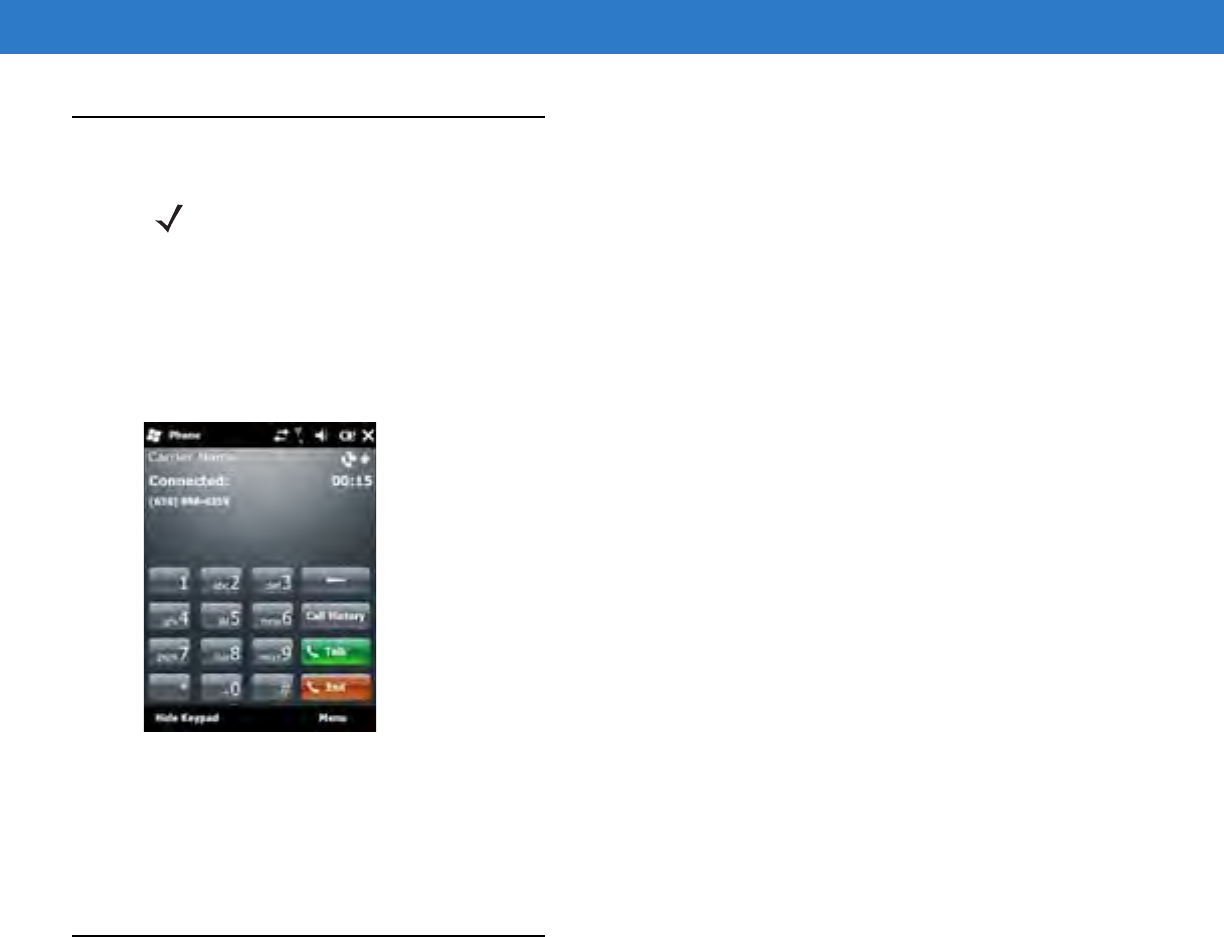
Using the Phone 4 - 21
Three-way Calling on an MC75A8
To create a three-way phone session with two people and you as the initiator:
1. Tap Start > Phone or press the green phone key on the MC75A’s keypad to display the Phone keypad.
2. Enter the first phone number and press Talk.
3. To call a second person, tap Keypad. Enter the second number and tap Talk.
Figure 4-33
Calling Another Person
4. When the second person answers the call, tap Talk to create a three-way calling session.
5. Tap Talk to drop the last call.
6. Tap End to drop the first call.
Text Messaging
Use the Text Messages window to send and receive text messages to and from mobile phones. The text can
contain words, numbers, or an alphanumeric combination no longer than 160 characters.
Short text messages delivered over mobile networks transmit from the sending MC75A, are stored in a central
short message center, then forwarded to the destination mobile device. If the recipient is not available, the
message is stored and can be sent later.
Viewing Text Messages
To view a text message:
You can view a text message whether the phone is on or off. When the phone is on, you can view a text message
from its notification callout. Tap the text message notification icon on the navigation bar to display the message.
NOTE Three-way Calling may not be available on all services. Please check with your service provider for availability.
DRAFT
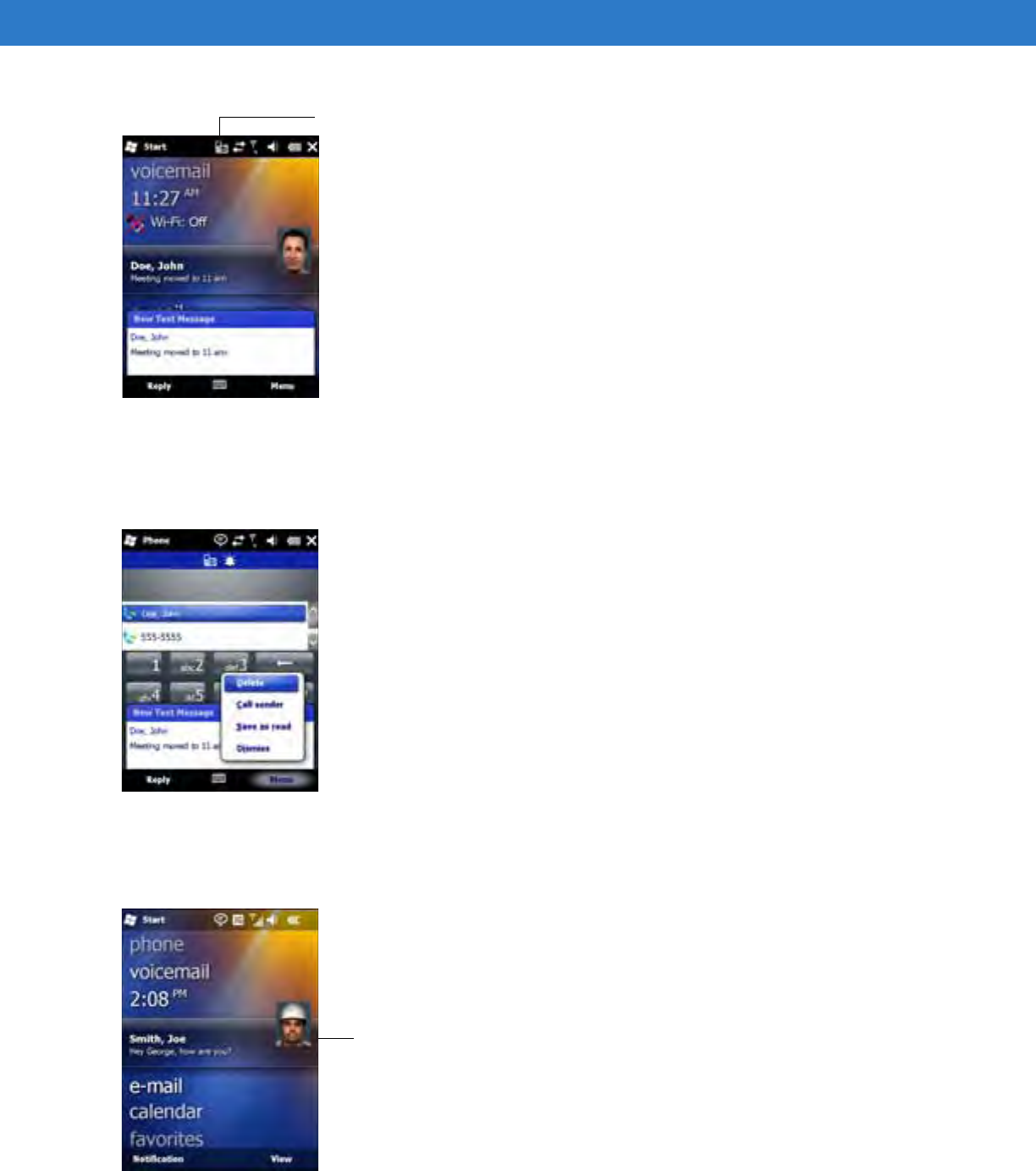
4 - 22 MC75A Enterprise Digital Assistant User Guide
Figure 4-34
New Text Message Notification
The Caller Identification feature matches incoming text message numbers with those stored in Contacts so you
know who is sending you a message. Furthermore, the New Text Message dialog box gives you the option to call
the sender or save, dismiss, or delete the message.
Figure 4-35
New Text Message Options
When the phone function is off, you can still view received text message in Messaging:
1. Tap Start > Text or on the Today screen, tap the text message on the Information Bar.
Figure 4-36
Text Messaging on Today Screen
Text Message Notification Icon
Tap to View Text Messages.
DRAFT
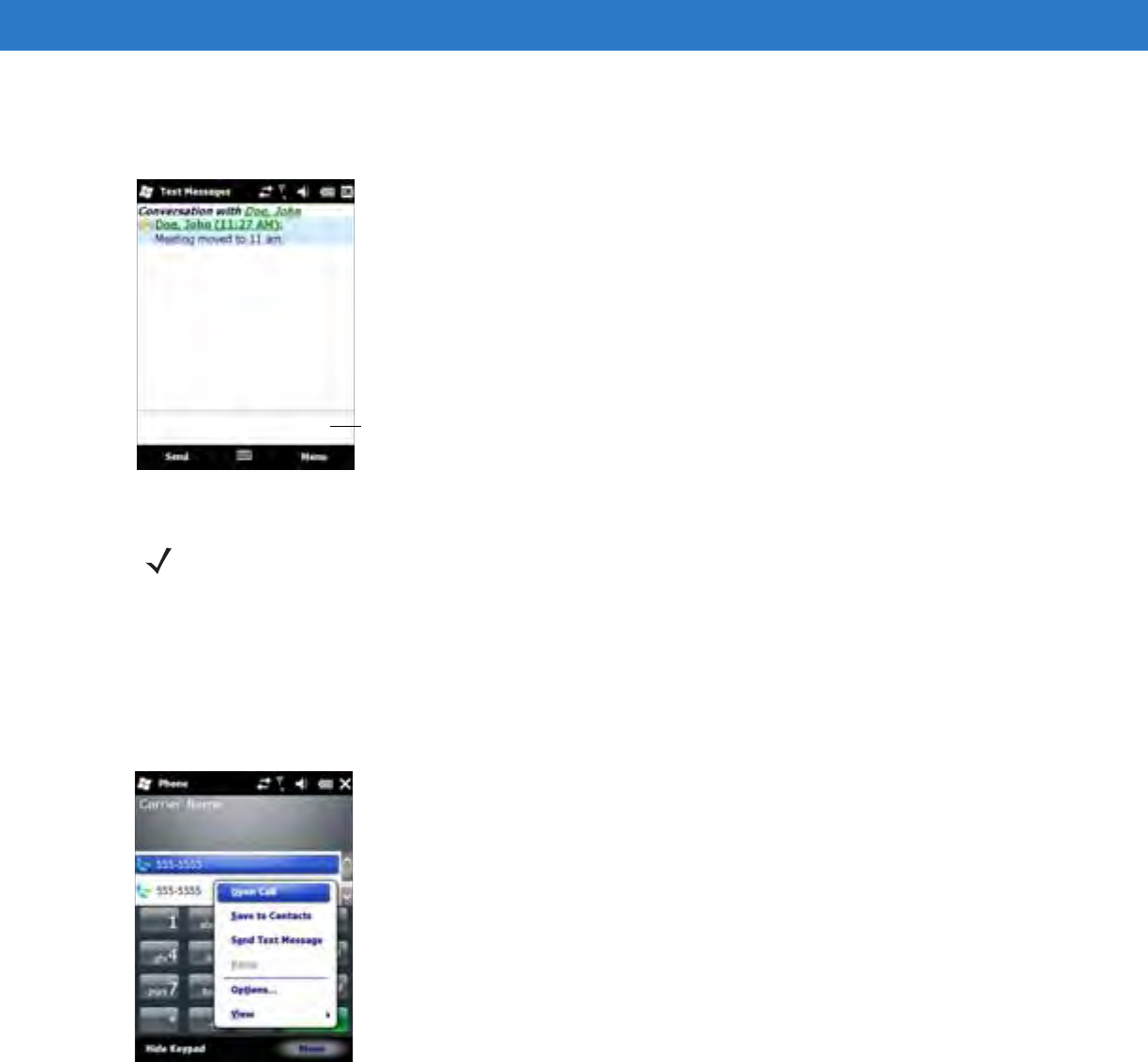
Using the Phone 4 - 23
2. The Text Messages window appears.
3. In the message list, tap the text message.
Figure 4-37
Text Messages List
Sending a Text Message
To create a text message:
1. On the Phone screen, select a contact name that you want to send a message to.
2. Tap Menu > Send Text Message.
Figure 4-38
Phone Screen Contact List
3. Compose your message.
Enter reply here.
NOTE If the phone is turned off and you tried to call the sender, send a reply, or forward the message, you are
prompted to turn the phone function on.
DRAFT
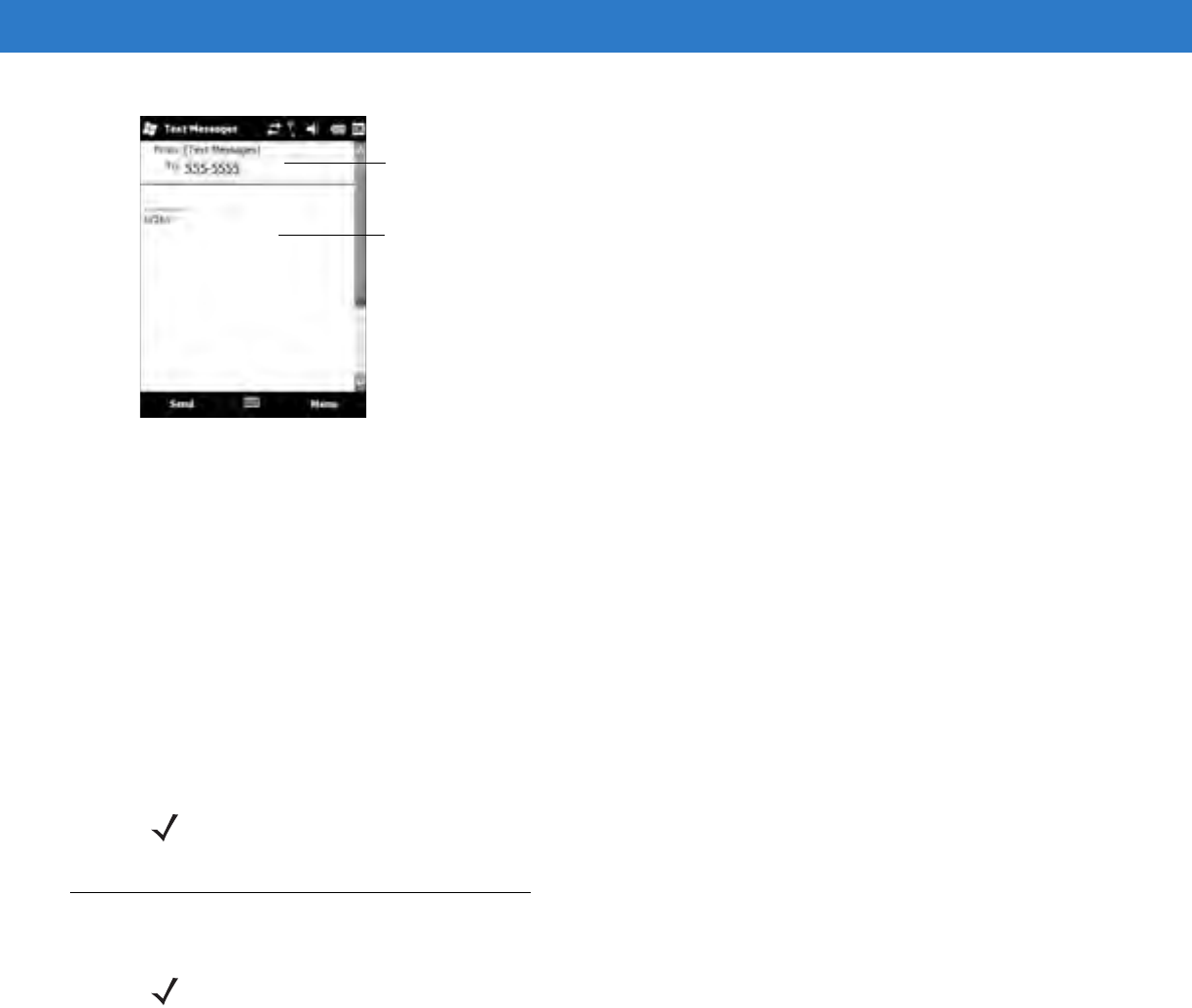
4 - 24 MC75A Enterprise Digital Assistant User Guide
Figure 4-39
Create Text Message
•The auto-correct feature automatically fixes common spelling errors as you type so your messages are
more accurate.
•The character counter lets you see and control the size of the message as you compose.
•If you want to know if your text message was received, tap Menu > Message Options, then select the
Request message delivery notification check box.
4. Tap Send when you've finished the message.
If the phone is turned on, your text message is sent. If it’s off, you are prompted to turn on the phone. If you do
so, the message is sent; otherwise when you tap OK, the message is saved in the Drafts folder and sent when
the phone is turned on.
If you are out of coverage area, the message is saved in the Drafts folder and sent when you return to a
coverage area.
Using a Dual Line SIM
Dual line SIM cards allow for two phone lines on a single card. For example, one line can be a business phone line
and the other a personal phone line.
To switch between phone lines:
1. Tap Start > Programs > SIM Toolkit.
Address Area
Message Area
NOTE On MC75A6 devices, the message remains in the Drafts folder and has to be manually re-sent when you
return to a coverage area.
NOTE Dual Line SIM support is only available on MC75A6 configurations.
Check with your service provider for availability.
DRAFT
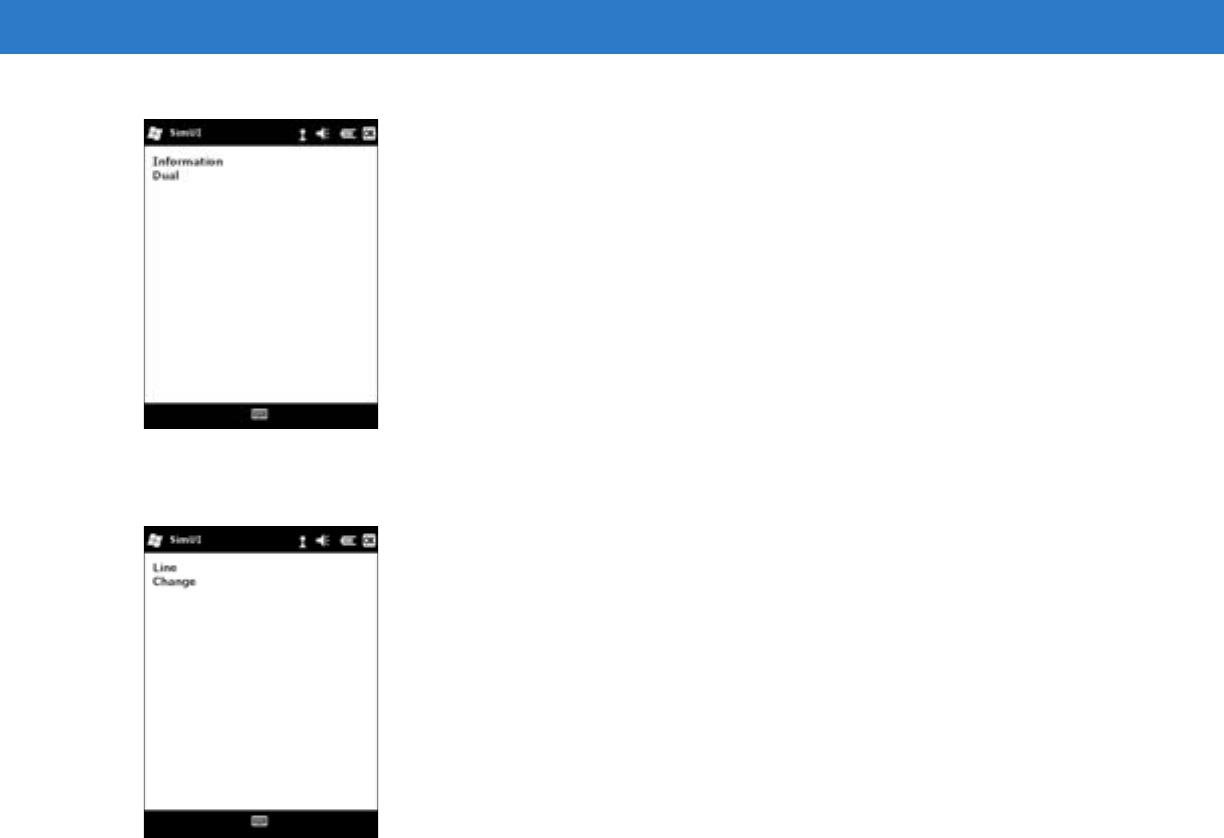
Using the Phone 4 - 25
Figure 4-40
SIM UI Window
2. Select Dual and then tap Select.
Figure 4-41
Change Phone Line
3. Select Change and then tap Select.
4. If applicable, sign in with the PIN number for the other line.
DRAFT

4 - 26 MC75A Enterprise Digital Assistant User Guide
DRAFT
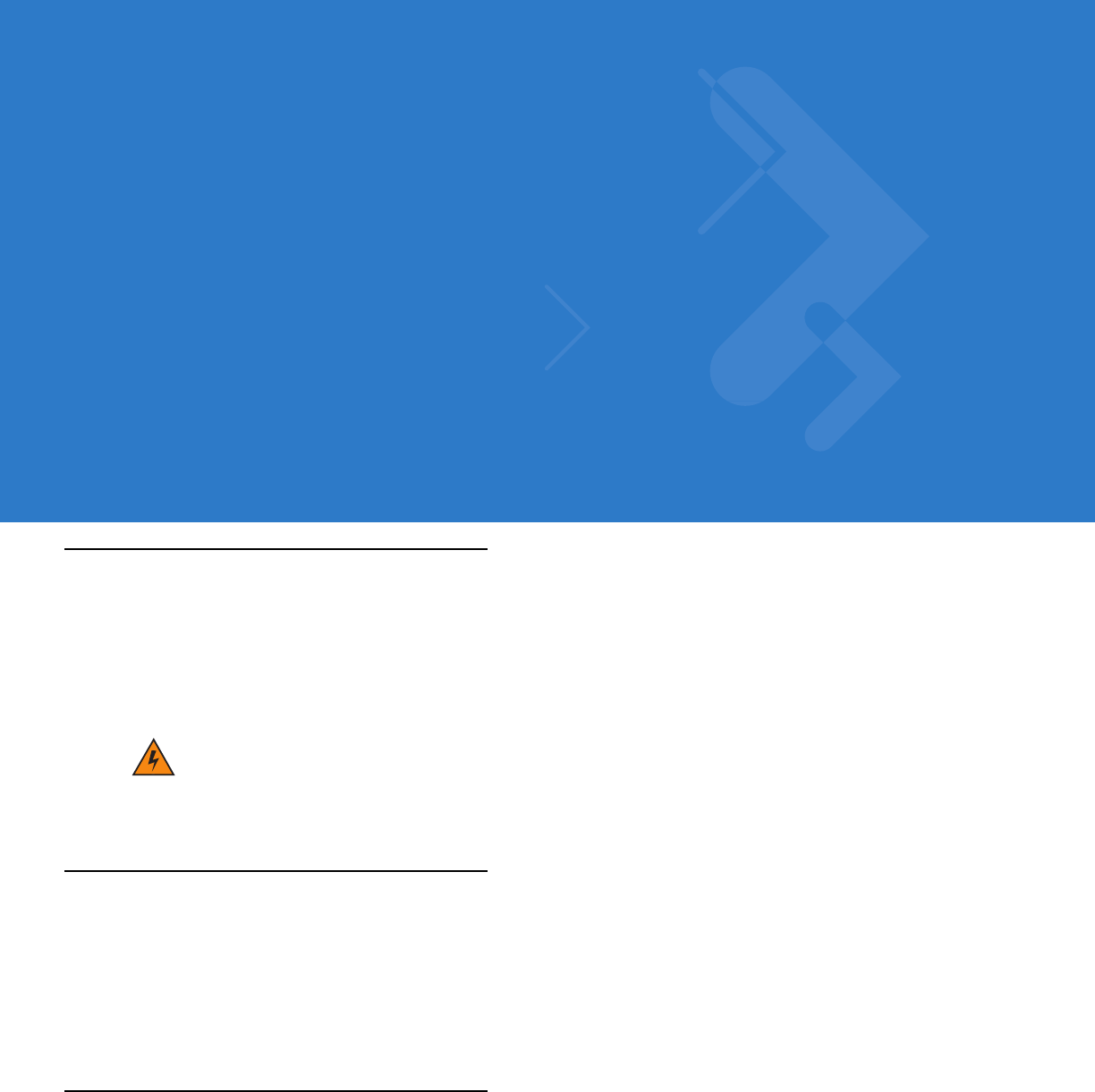
Chapter 5 Using GPS Navigation
Introduction
The MC75A includes Global Positioning System (GPS) technology using the SiRF III chipset. GPS technology is
based on a worldwide system of GPS satellites orbiting the earth that continuously transmit digital radio signals.
These radio signals contain data on the satellites’ locations and their exact clock time and are used to determine
your location on the earth.
Software Installation
Third-party GPS navigation software is required. Evaluation software is available from various suppliers. For
example; VisualGPS, visit: http://www.visualgps.net/VisualGPSce/
If interested in purchasing GPS navigation software check with the GPS software vendor (before purchasing,
downloading, or installing any software) to determine that the application is compatible with the MC75A. Refer to
the application’s user guide for application installation and setup information.
MC75A GPS Setup
The GPS-enabled MC75A operating system automatically manages access to the GPS receiver to allow multiple
programs to simultaneously access GPS data.
By default, the MC75A has the following settings:
1. Tap Start > Settings > System > External GPS icon.
2. In the Programs tab, the GPS program port is set to COM8.
3. In the Hardware tab, the GPS hardware port is set to GMX1.
WARNING!When using the MC75A in a vehicle, it is the user’s responsibility to place, secure and use in a
manner that will not cause accidents, personal injury or property damage or obstruct their view. It
is the responsibility of the driver to operate the vehicle in a safe manner, maintain observation of
all driving conditions at all times, and not become distracted by the device to the exclusion of safe
driving practices. It is unsafe to operate the controls of the device while driving.
DRAFT
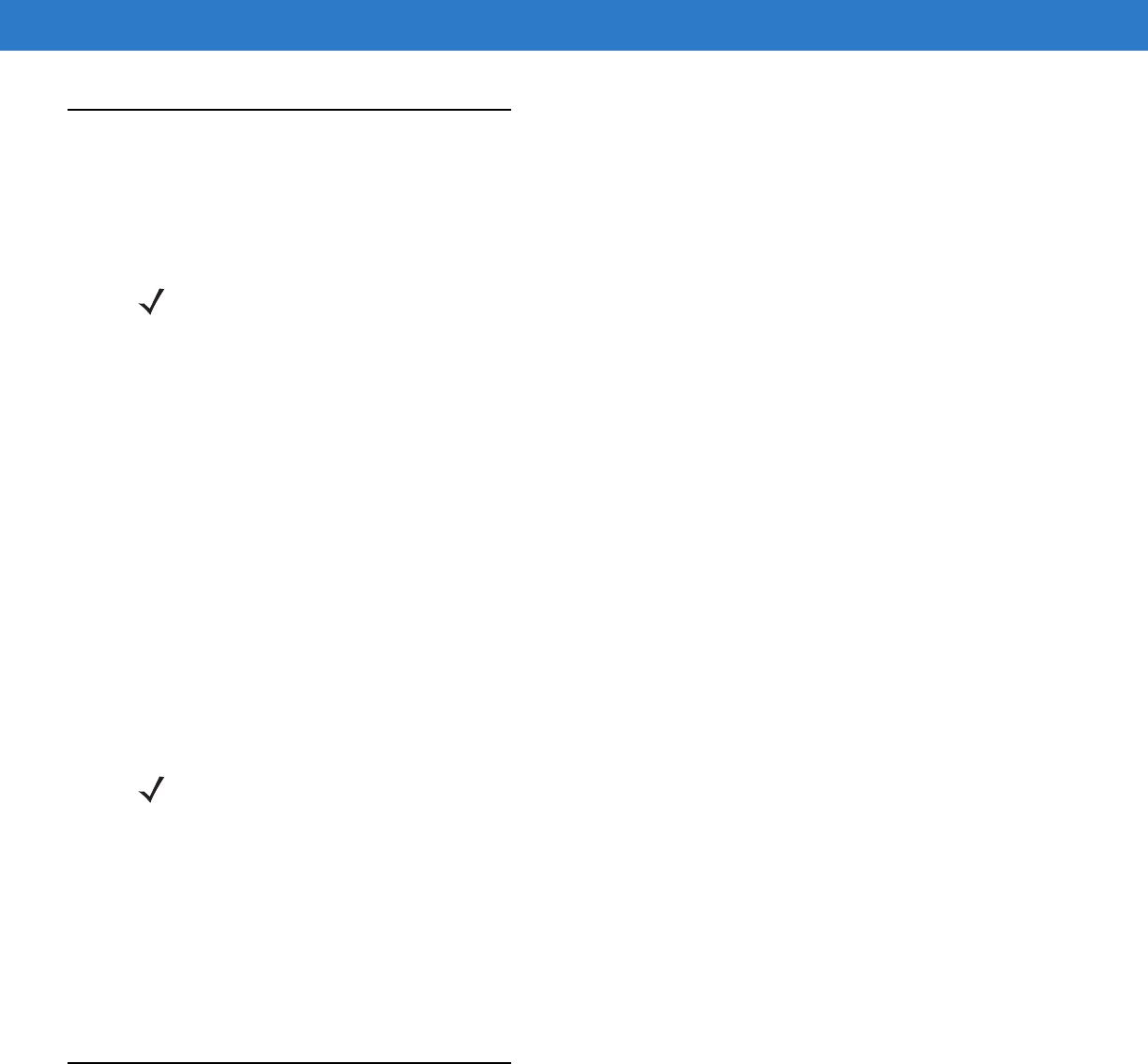
5 - 2 MC75 User Guide
Operation
Acquiring satellite signals may take a few minutes. It is best to be outside and have a clear, unobstructed view of
the sky. Without a clear view, acquisition takes much longer and could result in the MC75A being unable to
compute the initial position quickly. When operating the device indoors access to the GPS signals may be limited or
unavailable.
GPS Maps on microSD Cards
GPS navigation software vendors may sell maps on microSD cards. If using a microSD card with the GPS
navigation software:
1. Remove the Memory Card Cover on the side of the MC75A.
2. Insert the microSD card into the slot.
3. Replace the Memory Card Cover.
Answering a Phone Call While Using GPS
If you receive a phone call while using your GPS navigation software:
1. Answer the phone call by pressing the Answer button.
2. Once you end the phone call, press the End Call button to resume the audio on the GPS software.
Losing the GPS Signal While in a Vehicle
GPS performance on the MC75A may be affected if the vehicle has thermal glass windows and windshields, which
can block the MC75A from receiving a GPS signal from satellites. To improve GPS signal strength, place the
MC75A where there is a clear view of the sky. A direct line of sight is required between the MC75A and the GPS
satellites to access information from the satellites.
The Global Positioning System (GPS) is a system that allows the user to track their position anywhere on the earth.
Assisted GPS
GPS can be used in stand-alone or Assisted GPS (A-GPS) modes. A Stand-alone GPS receiver downloads data
from GPS satellites. It can take several minutes to get a fix. By using GPS Location servers, A-GPS dramatically
improves the performance of the Time To First Fix (TTFF) of GPS receivers by providing them with data that they
would ordinarily have to download from the GPS satellites. With the A-GPS data, GPS receivers can operate faster
and more reliably.
A-GPS follows the Secure User Plane Location (SUPL) protocol which allows the MC75A to communicate with a
location server.
NOTE When using a GPS navigation application, ensure that the MC75A does not go into suspend mode. If the MC75A
suspends then the power to the GPS radio is removed. Upon resume the GPS receiver must reacquire a valid GPS
signal, resulting in a a delay of positional information.
NOTE Anytime you are using GPS on the MC75A and you receive a phone call, the audio on the GPS navigation software
is muted until you finish the call.
DRAFT
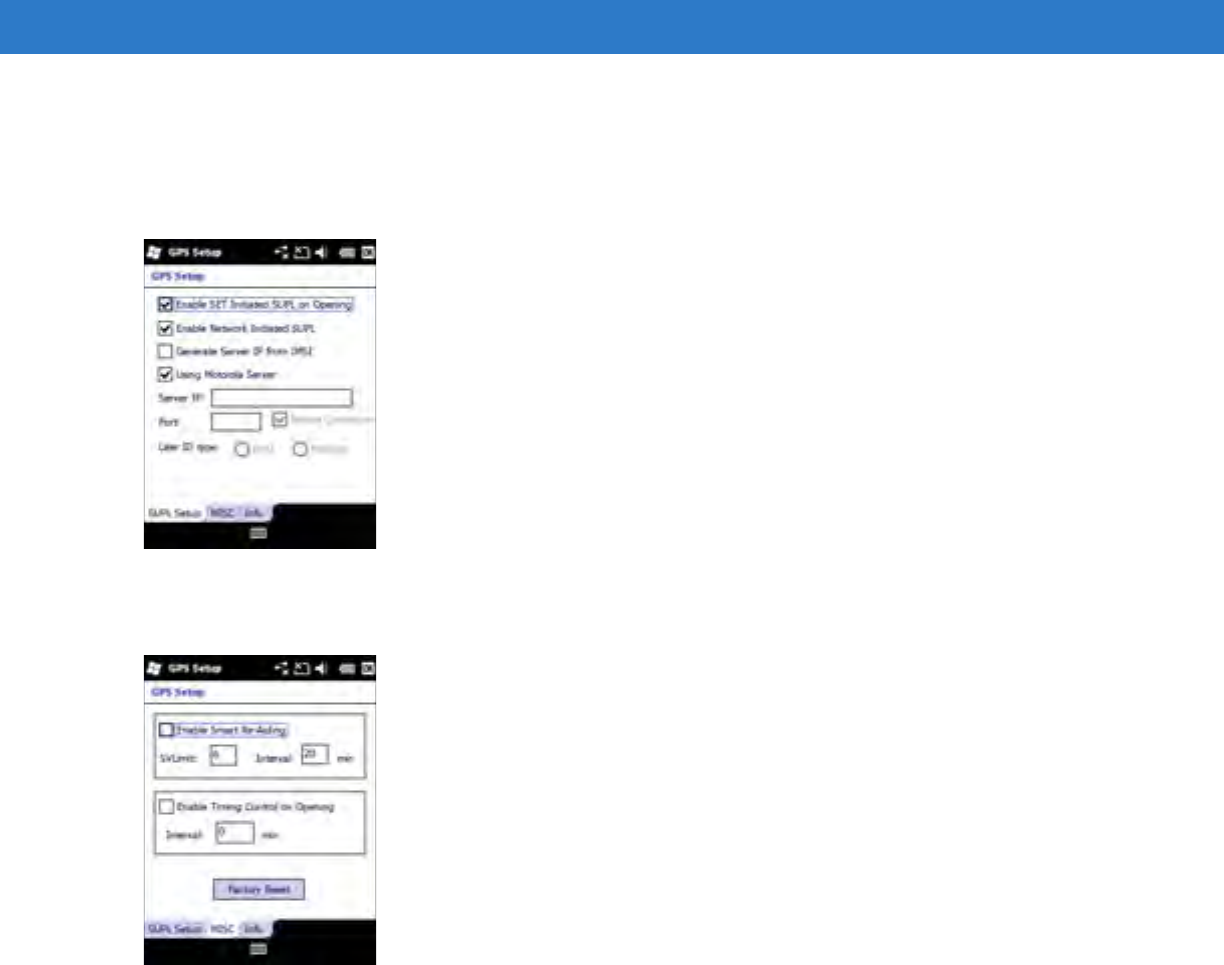
Using GPS Navigation 5 - 3
Figure 5-1
SUPL Setup Tab
Figure 5-2
MISC Tab
DRAFT
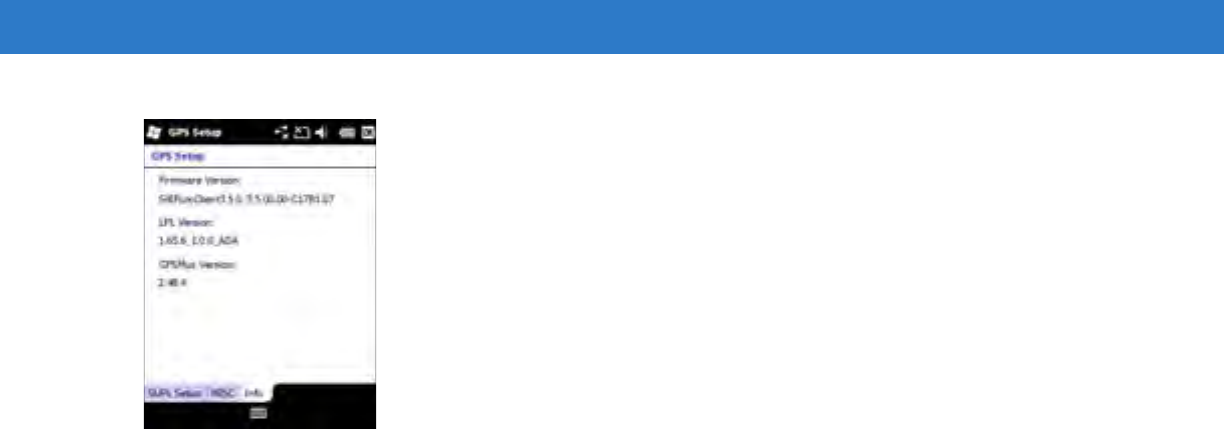
5 - 4 MC75 User Guide
Figure 5-3
Info Tab
DRAFT
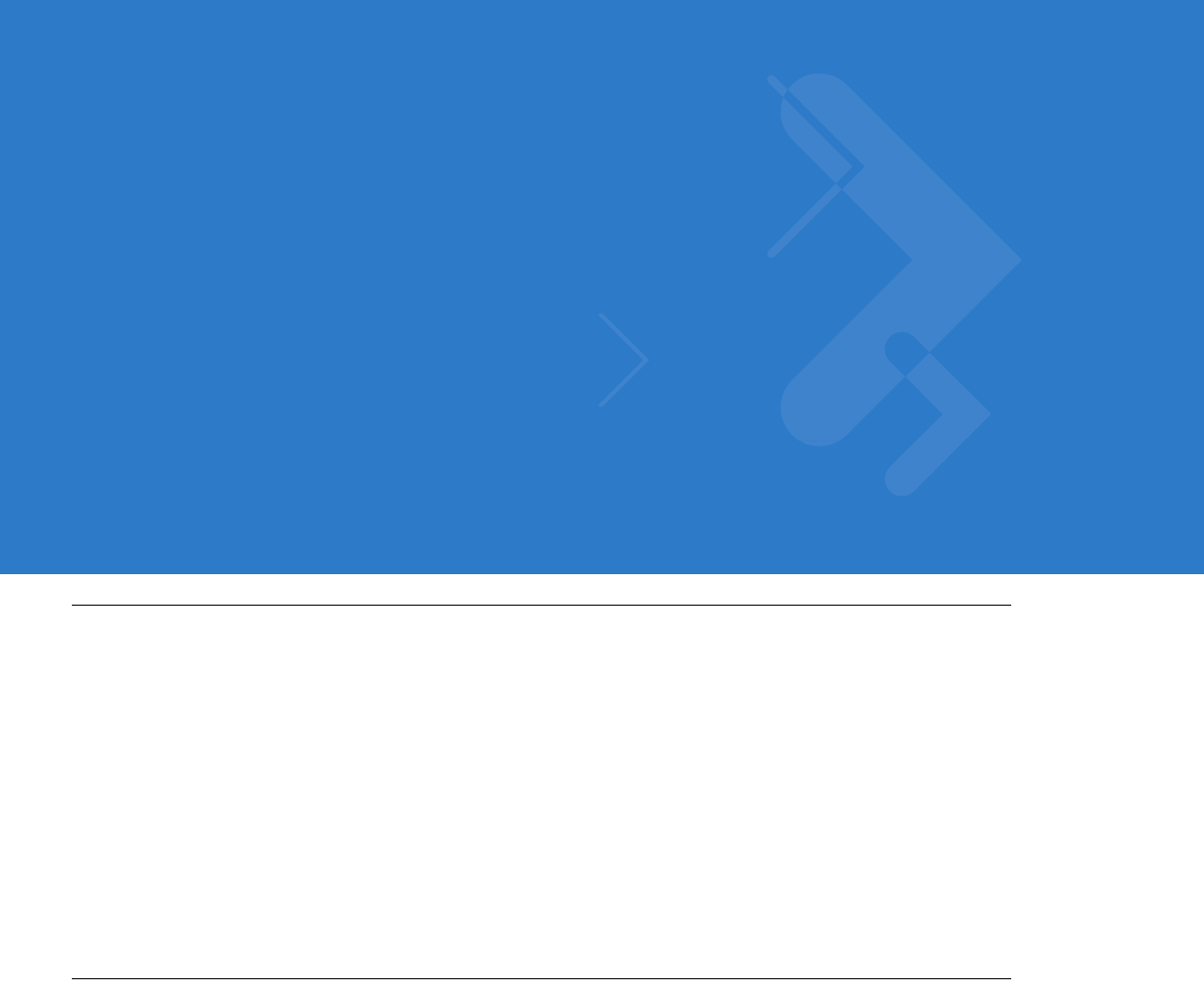
Chapter 6 Using Bluetooth
Introduction
Bluetooth-equipped devices can communicate without wires, using frequency-hopping spread spectrum (FHSS)
radio frequency (RF) to transmit and receive data in the 2.4 GHz Industry Scientific and Medical (ISM) band
(802.15.1). Bluetooth wireless technology is specifically designed for short-range (30 feet/10 meters)
communication and low power consumption.
MC75As with Bluetooth capabilities can exchange information (e.g., files, appointments, and tasks) with other
Bluetooth enabled devices such as phones, printers, access points, and other mobile computers. To use the
MC75A as a modem, create a dial-up modem connection between a computer and MC75A.
The MC75A with Bluetooth technology uses either the StoneStreet Bluetooth stack or the Microsoft Bluetooth
stack. To write an application that uses the StoneStreet One Bluetooth stack APIs, refer to the Enterprise Mobility
Developer Kit (EMDK) Help.
Adaptive Frequency Hopping
Adaptive Frequency Hopping (AFH) is a method of avoiding fixed frequency interferers, and can be used with
Bluetooth voice. All devices in the piconet (Bluetooth network) must be AFH-capable in order for AFH to work.
There is no AFH when connecting and discovering devices. Avoid making Bluetooth connections and discoveries
during critical 802.11b communications. AFH for Bluetooth consists of four main sections:
•
Channel Classification - A method of detecting an interference on a channel-by-channel basis, or pre-defined
channel mask.
•
Link Management - Coordinates and distributes the AFH information to the rest of the Bluetooth network.
•
Hop Sequence Modification - Avoids interference by selectively reducing the number of hopping channels.
•
Channel Maintenance - A method for periodically re-evaluating the channels.
When AFH is enabled, the Bluetooth radio “hops around” (instead of through) the 802.11b high-rate channels. AFH
coexistence allows Motorola mobile computers to operate in any infrastructure.
DRAFT

6 - 2 MC75A Enterprise Digital Assistant User Guide
The Bluetooth radio in this MC75A operates as a Class 2 device power class. The maximum output power is
2.5mW and the expected range is 32.8 feet (10 meters). A definition of ranges based on power class is difficult to
obtain due to power and device differences, and whether one measures open space or closed office space.
Security
The current Bluetooth specification defines security at the link level. Application-level security is not specified. This
allows application developers to define security mechanisms tailored to their specific need. Link-level security
occurs between devices, not users, while application-level security can be implemented on a per-user basis. The
Bluetooth specification defines security algorithms and procedures needed to authenticate devices, and if needed,
encrypt the data flowing on the link between the devices. Device authentication is a mandatory feature of Bluetooth
while link encryption is optional.
Pairing of Bluetooth devices is accomplished by creating an initialization key that is used to authenticate the
devices and create a link key for them. Entering a common PIN number in the devices being paired generates the
initialization key. The PIN number is never sent over the air. By default, the Bluetooth stack responds with no key
when a key is requested (it is up to user to respond to the key request event). Authentication of Bluetooth devices
is based-upon a challenge-response transaction. Bluetooth allows for a PIN number or passkey that is used to
create other 128-bit keys used for security and encryption. The encryption key is derived from the link key used to
authenticate the pairing devices. Also worthy of note is the limited range and fast frequency hopping of the
Bluetooth radios that makes long-distance eavesdropping difficult.
Recommendations are:
•
Perform pairing in a secure environment
•
Keep PIN codes private and don't store the PIN codes in the mobile computer
•
Implement application-level security.
The Microsoft stack supports Smart-pairing. For detailed information, refer to the Microsoft MSDN.
The StoneStreet One Bluetooth stack supports Secure Simple Pairing. Secure Simple Pairing improves the pairing
experience for Bluetooth devices and increasing the use and strength of security. Both the host and the remote
device must support Secure Simple Pairing. If one device does not, standard pairing will be used, as described
above.
NOTE It is not recommended to perform Bluetooth wireless technology inquiry when high rate 802.11b operation is
required.
DRAFT
